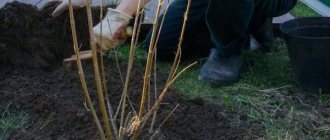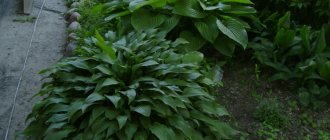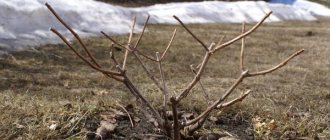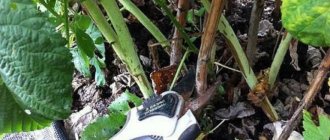Buddleya is one of the most unpretentious shrubs that blooms from July to November, i.e. almost all summer and autumn. Covering itself with long and lush buds, it emits a divine honey scent that attracts butterflies to the garden.
However, despite all the unpretentiousness of the "autumn lilac", every year at the end of the growing season it needs some preparation for winter, namely pruning and shelter. Read on to learn how to care for and properly prepare a buddley for winter.
By far the most popular variety is David's buddley (also called volatile). The fact is that it is most suitable for growing in the conditions of the Central strip (Moscow region) and in other regions of Russia. However, there are also other types of buddleia: spherical, alternate-leaved, white-flowered, snowy and Japanese.
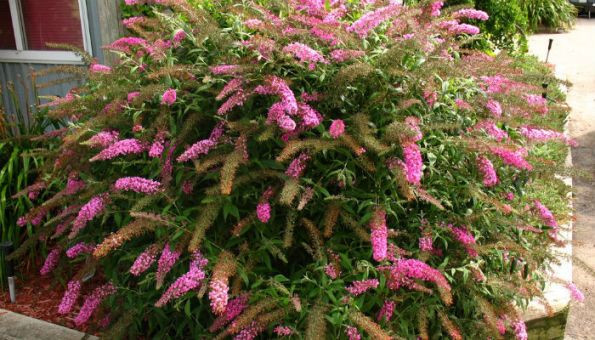
General tips and tricks about the features of autumn care and preparation for winter
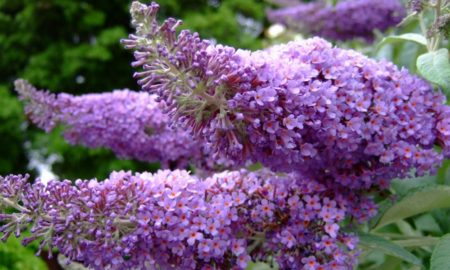

Lush budley bushes resemble lilacs during flowering. This period falls in autumn, when most of the garden plants are already entering the dormant stage. David's budley is most adapted to the Russian climate. This species is characterized by fast growth and early flowering. But even he needs careful preparation in the fall in order to successfully survive the winter. David's Buddley needs to not only be properly pruned, but also watered and fertilized.
Correct stem pruning
Most of the shrub plants grown in Russia are simply thinned out in the fall. Such a scheme is not suitable for a budley. It needs to be cut to fit the stump. This makes it possible to successfully grow budley even in northern climates, since the remaining part with a height of no more than 20 cm is easier to cover for the winter.
Watering and fertilizing
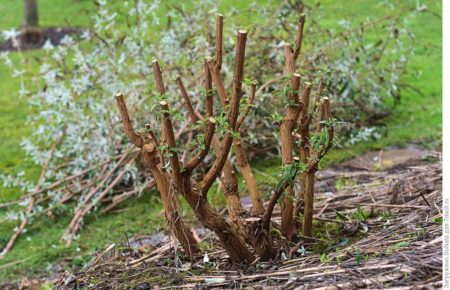

Budlea tolerates a prolonged lack of moisture, but it requires timely watering if the autumn is dry. In this case, the soil is moistened after it has completely dried out using settled water.
For high-quality flowering, the last feeding of the budley should contain a lot of potassium and phosphorus. Fertilizers are applied before the beginning of the flowering period. Then the feeding is stopped in order to induce the plant to the beginning of the dormant period in conditions of a lack of nutrients.
How to keep budley in winter
Often, when caring for a budley, even experienced gardeners face difficulties associated with the fact that the plant is reluctant to emerge from the winter state of dormancy and begins to grow greens only by autumn. In some cases, the shrub freezes completely. It will not be possible to completely insure your plant against this problem, but you can reduce the risk if you follow simple recommendations for winter care:
- At the age of 1 - 2 years, even the most winter-hardy species, such as Buddley Vicha or Buddley David, are moved to a pot for the winter and placed in a dark, well-ventilated room or basement. The air temperature should not exceed 10 - 12 ° C. In this form, the shrub will overwinter without problems in the absence of watering and light, and in April it can be transplanted to a permanent place.
- The last feeding of budley should be carried out no later than the beginning of autumn: best of all in June-August.
- All plants in areas where the temperature drops below -5 ° C are subject to shelter. If there is no need for more complex structures, you can protect the shrub with spruce branches or brushwood.Snow is also great for cover.
- It is better not to use sawdust and autumn foliage to protect budlea from the cold. This material retains water and does not allow air to circulate, which can cause the plant to rot.
- Before the construction of the protection, the budley shrub is subjected to hilling to the height of the 3rd bud on the remaining stem. The primer used for the procedure must be dry.
If you follow these rules for care, then the plant will easily survive the autumn cold snaps and the most severe cold.
Autumn pruning
For shrubs with a high growth rate, it is very important to periodically cut the branches. Timely autumn pruning is the key to lush flowering.
The need for pruning
Periodic removal of the branches of the shrub contributes to a long and abundant flowering. The expediency of this procedure is explained by a number of factors:
- budlea branches stretch out strongly if they are not cut off in time, so the bush quickly loses its attractiveness;
- regular pruning develops resistance to diseases and allows the plant to quickly adapt to the climate;
- after pruning, the budlea blooms magnificently;
- for plants grown as hedges, cutting the branches sets the shape.
The right time to trim
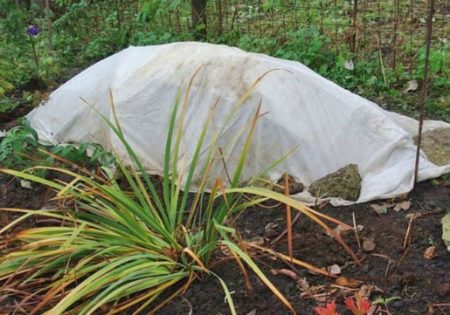

The removal of the branches of the shrub is carried out in October or November, after the leaves turn black. A plant cut off at this time is much easier to close for the winter. This is important in order to successfully preserve budley in winter in conditions of growth in the central part of Russia or in the Northern regions.
Optimal pruning scheme
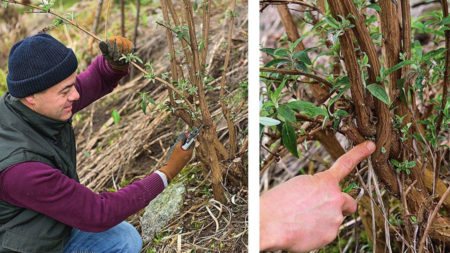

Initially, all faded inflorescences are removed. They greatly spoil the appearance of the plant. Then the shrub is cut under the stump. Moreover, for young budleys, no more than 20 cm of a shoot with three buds is left above the soil. In bushes that are more than 2 years old, a third of the length is left from the shoot. This is enough for the plant to start growing with the onset of spring and quickly restore its decorative effect. In addition, short-cut bushes are easier to cover for wintering.
A sharpened knife or garden pruner is used to cut the shoots. It is advisable to pre-sterilize the tool. The place of the cut must be treated with garden pitch.
How to care for a budley after pruning
There is no need to carry out any special measures for caring for the budley after a haircut. It is enough just to collect the cut off shoots and destroy them. During this period, the plant does not need feeding, since it begins a dormant period.
How to propagate budley
Reproduction of budleya is possible in two ways. Each of them has its own right to use.
Seed propagation
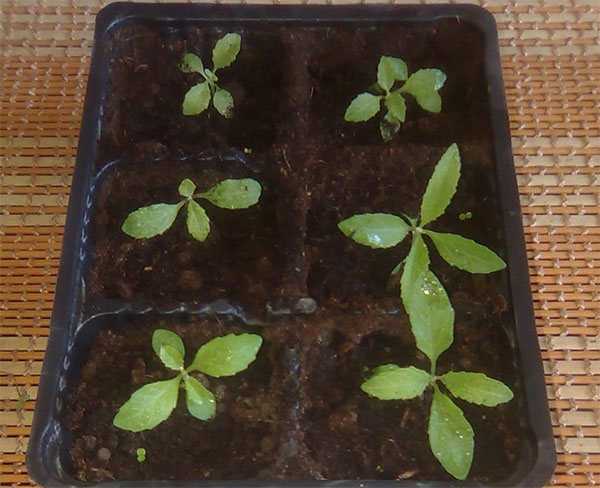

This is a very time consuming method. The seeds can be bought at a specialty store or harvested from a bush in late autumn. But whether the seeds collected with their own hands will sprout depends on whether they ripened well enough. The fact is that, for example, planting a budley and leaving in Siberia in the open field behind it is possible. But seeds in cold climates do not have enough time to ripen. Therefore, it is better to give preference to purchased seeds.
The soil used for sowing must be neutral in acidity. The seeds, since they are very small, are best mixed with sand. They are sown on loose soil and slightly nestle. The container is covered with foil or glass. Watering is done with a spray bottle. The container is placed in a warm and bright place.
The planting material should be regularly ventilated and moistened. The first shoots appear on days 14-21. At the stage of appearance of 3-4 leaves, the seedlings dive into separate pots. Only with the onset of persistent heat in the spring begins planting and caring for budley in the ground in the open air.
Propagation by cuttings
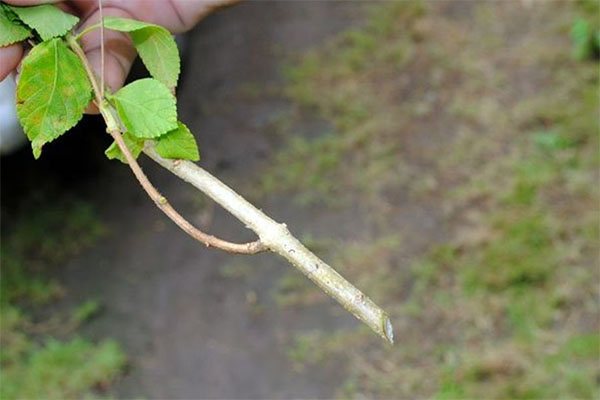

For propagation by cuttings, you can use young spring shoots 15-20 centimeters long or woody twigs cut in the fall. On the cuttings, the lower buds are removed and treated with a growth stimulant.The twigs are buried 3-5 cm in the ground and covered with foil. Rooting takes place over two months. The film is removed only after the appearance of new shoots.
Regardless of which method of plant propagation is chosen, the first stages of germination and rooting are best done at home. Planting and caring for a budley in the open field is possible only after the onset of warmth.
Shelter for the winter
It is customary to cover many garden plants for the winter in order to improve their survival in conditions of prolonged cold. This is especially true for such thermophilic representatives of exotic flora as autumn lilacs, since they are not initially adapted to severe frosts.
For a shelter, you will need a spacious box of boards or several arcs in combination with a covering material. You will also need mulch.
The need for winter shelter
The natural habitat of Budleia is the tropics and subtropics with a constantly warm and humid climate. In Russia, the temperature drops significantly in winter. Therefore, frosts of -20 degrees lead to freezing of the shoots of the southern beauty. If the thermometer drops even lower, the bush dies.
Shelter technology and timing, materials required
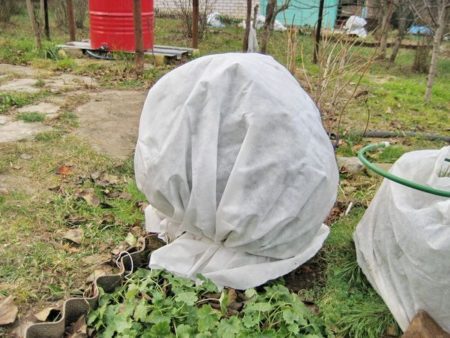

You can cover the budley for the winter after autumn pruning, when the plant enters a dormant state. This is done exclusively in dry weather in the absence of strong winds. If, during the warming, the branches of the plants are damp, they will begin to rot and the bush will die.
Adult bushes are insulated as follows:
- After pruning the plant, the remaining part is completely covered with dry soil.
- A plank box or other suitable container is placed on top.
- Cover the structure with roofing material or slate.
- During the winter, snow is periodically poured over the shelter.
Covering the budel in this way, it is undesirable to use polyethylene or insulation in the form of wood chips. These materials cause the plant to decay.
In another version, the shelter is built in the form of a kind of mini-greenhouse. The plant is also completely covered with dry soil. Then the trunk circle is mulched, laying peat or rotted manure. Arches made of wood or metal are placed on top, observing a distance of 30 cm to the ground surface. The structure is tightened with a suitable covering material. To do this, use film, spunbond or lutrasil. As additional protection in conditions of a significant drop in temperature, hay or dried foliage is piled on top.
Possible mistakes
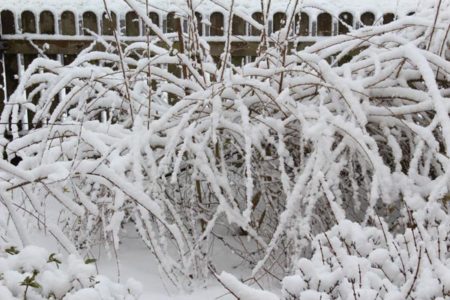

Many inexperienced gardeners build a shelter for the winter incorrectly, which leads to the death of the plant or freezing of the branches. Typical mistakes are:
- construction of a shelter in wet weather, which leads to rotting of the buds and damping of the root collar;
- lack of ventilation during a thaw;
- fertilization in the fall extends the growing season.
How to cut a budley for the winter
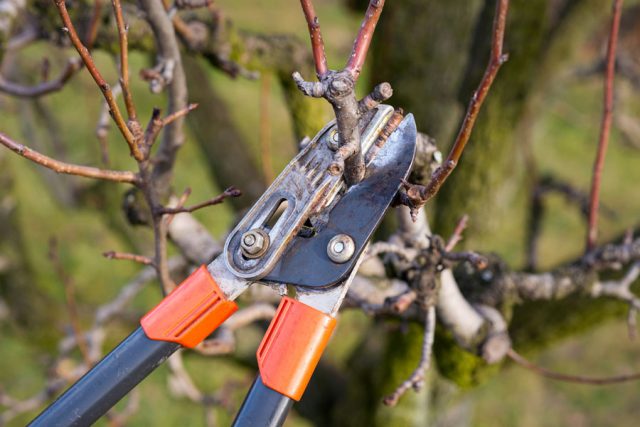

Budleia pruning is another important step in bush care. Often this procedure is understood as spring pruning, which precedes the growing season. However, budley is cut off in the fall, before sending it to winter. This method of care is not aimed at giving the plant an aesthetic appearance, but has a practical purpose - to make it easier to live in late autumn and winter.
Do I need to cut budley for the winter
As a tropical crop, Budla is quite sensitive to low temperatures. Even frost-resistant varieties, such as David's buddleya, often endure the Russian cold with problems and need special preparation for winter. The ability to correctly prune a shrub in the fall affects how the plant will subsequently be covered and whether it can quickly wake up from wintering with the onset of warmth. Therefore, in temperate latitudes, pruning in autumn budleys is mandatory.
Preparation of tools and materials
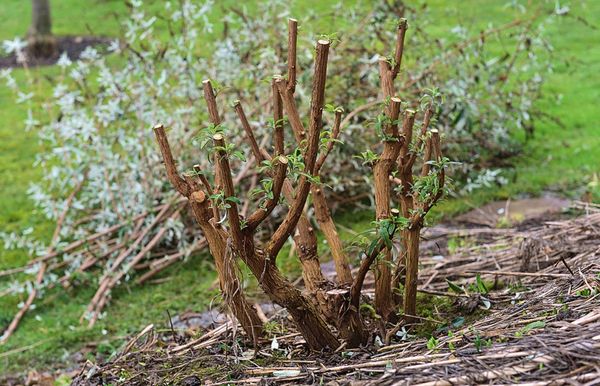

The procedure for trimming a budley in the fall does not require the purchase of any special tools. To do this, it will be enough to have a standard set of plant care, which can be found in every gardener. It includes:
- pruning shears for plant branches 25 mm thick;
- gloves;
- protective glasses.
If pruning in the fall is carried out over tree-like varieties of budlei, then it will not be superfluous to get hold of a stepladder and a lopper. The latter will help in removing thick branches up to 5 cm in hard-to-reach places of the crown of "autumn lilac".
Pruning time
Experienced breeders who know a lot about caring for budley advise pruning the shrub from the second half of autumn, as soon as its leaf plates begin to turn black. The timing of autumn pruning is influenced by the climatic conditions in the region and the kind of care the budley received during the season. As a rule, this procedure falls on the end of October - beginning of November.
How to properly trim a budley for the winter
Autumn pruning of buddleya does not require special skills and effort, however, when starting the procedure, one should take into account the area where the crop is grown and its variety. So, when pruning David's budley in autumn in areas close to the subtropical climate, you only need to shorten the branches by 5-10 cm. This will be enough for the plant to survive until spring. And even if, in the event of a sudden cold snap, the aboveground part of the budlea freezes over, the shrub will quickly release young shoots as soon as the weather is favorable.
In other climatic zones, they practice autumn pruning of budlei under a stump, leaving only cuttings of 20 cm above the ground. In this form, the plant will be easier to cover, and it will not suffer from frost.
Crop care after pruning
As soon as the autumn pruning is completed, no further maintenance of the budley is required, until the next summer season. All that remains to be done is to clear the area around the bushes of debris and take care of creating a shelter.
Preparing for winter, depending on the region
After completing the preparatory work, they choose the optimal method for arranging a winter shelter. In many ways, it depends on the characteristics of the climate in the region. The basic rule is that the lower the air temperature in winter, the thicker the mulching layer should be and the higher the height of the air gap.
Budleia protection for areas of the Middle Lane
In areas related to central Russia, it is optimal to build a greenhouse over the cut bush. For this, metal or wooden arcs and film are used.
Shelter for the winter in the Volga region
In this case, the shrub is covered with a film greenhouse, and mulch made of dense material is laid on top of it. An alternative is to cover the stump with cut spruce branches and place a wooden box on top.
Winter protection for Siberia and the Urals
In Siberian winter conditions, the prepared bush is covered with sawdust to protect it from frost. In this way, you can save budley only in Siberia or the Urals. In regions with warmer winters, sawdust will accumulate moisture from the melting snow, which will lead to kidney decay.
Wintering budley bushes
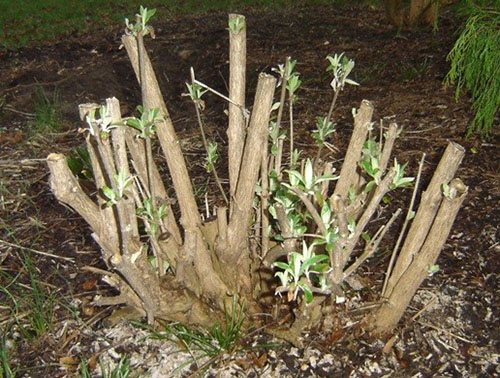

To get a gorgeous flowering bush, it is not enough to provide more planting and maintenance in the ground. Wintering in a warm place is the main condition for good growth and vigorous flowering. Budlea is very demanding on wintering conditions, since there are practically no severe frosts in its native halo of growth. In the climatic conditions of the middle zone, the ground part of this southern plant (if it is not covered) completely freezes in winter. Only the roots hidden in the ground remain alive, capable of giving new growth in spring under favorable conditions.
In order to be able to admire the flowers of the budlea in autumn, planting and care in the ground in the suburbs involves the creation of special conditions for the wintering period.From about the end of July, you should stop making any kind of plant nutrition, including mulching the trunks with compost. Also, from this period, ash and other fertilizers should not be applied to the soil. This is necessary so that the plant has time to prepare for winter.
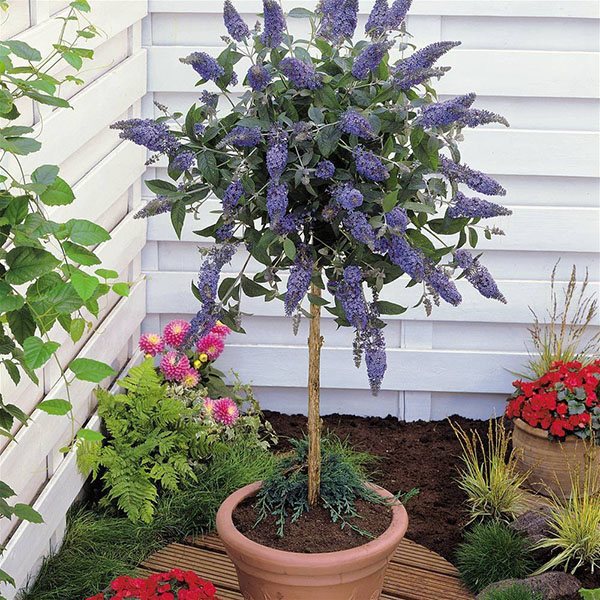

The signal that it is time to cover the plant is the leaves that have begun to turn black. This usually happens in October or November. To cover the bush, you should choose a dry, sunny day. The shelter should be built in the following order:
- Sprinkle the bush with dry soil up to the level of the third bud.
- Cut off the protruding stems, leaving branches approximately 20 cm long.
- Cover the bush with spruce branches.
- Cover the structure with a large wooden box on top.
- Place roofing material or slate on top of the box to protect the shelter from rain.
There should be enough air in the shelter for a safe wintering of the budley. Therefore, the film and sawdust are unsuitable for insulation. Under them, the branches of the plant, as well as its roots, can trample.
The construction of winter shelters makes it possible to plant and leave the budley in the Urals, and even in Siberia, in the open field. In these regions with cold winters, keeping the plant is much more difficult, but still possible. The main thing is to wait for persistent spring heat without frost, and only then open the bush. Snow also helps a thermophilic plant to winter well. It retains heat well inside the shelter.
Is it worth planting or replanting budley in the fall
It is preferable to replant or plant in a permanent place in the spring. This plant has a taproot that goes deep into the ground, which is easy to damage during transplantation.
Preparation
For a budlea, it is important to choose a place closed from drafts with good lighting or light partial shade. The soil should periodically dry out, since the abundance of water on the site leads to rotting of the roots. For good development of a highly expanding root system, plants should not be planted densely.
The transplant is performed as follows:
- The bush is dug out, trying to preserve the integrity of the roots as much as possible.
- A new planting hole is made, the size of which is twice the size of the root system.
- A 10 cm thick drainage layer is placed on the bottom.
- A little soil is poured, consisting of an equal amount of black soil, leafy earth and humus.
- The plant is placed in a pit, aligning the root collar with the soil level, and covered with prepared soil.
- Compact the soil around the trunk.
Post-transplant care
The transplanted plant is abundantly watered with settled lukewarm water. It is best to pour water into a groove dug around the plant. So, the root system is saturated with moisture more evenly. In the future, the plant is watered only after the soil has completely dried out.
Reproduction in autumn
For propagation of budlei in autumn, a vegetative method is used. Cuttings are harvested after pruning the plant and immediately planted in fertile soil in containers and stored in the basement. Periodically they are watered and ventilated. When the warm weather finally settles, the plants are transplanted to a permanent place.
How to plant a budley in the fall
Planting budleys in open ground in autumn is not much different from the same process in spring. In the autumn period, the choice of a seat must be approached with special care, giving preference to sunny areas protected from drafts. It is best to carry out an autumn planting on a sunny dry day at a temperature not lower than +10 ° C.
The type of soil is not particularly important for the plant; it can grow in almost any area. The main thing is that the soil is not excessively wet, otherwise the root system will begin to rot.
Having decided on the place, you can start planting the "autumn lilac":
- First, a hole is dug with a depth of 30 - 40 cm. In width, it should be 2 times the diameter of the budley rhizomes.
- Then a high-quality drainage is laid on the bottom of the recess with a layer of 10 - 15 cm.For these purposes, peat, shavings or charcoal are suitable.
- A layer of organic sub-crust is placed on top of the drainage material, for example, compost mixed with ash.
- Next, half of the previously prepared soil is poured into the pit.
- The plant is dug up together with an earthen clod, making sure that the roots are not exposed.
- Carefully move the buddle to the selected location.
- Fill up the remaining soil.
- After that, the soil is tamped. If in the autumn period in the next 2 weeks cold weather and precipitation are not expected, then the near-trunk circle of the bush is watered abundantly.
If you plant a budley in the fall according to all the rules and organize proper care for it, then it will have time to take root before the frosts hit. However, the chances of success will be much higher in regions where temperature changes are not dramatic. But even in this case, it is worth remembering that planting in the fall is quite traumatic for the plant, and it is not worth doing it without extreme need.
"Hairstyle" for buddleya: features of spring pruning
Do you want your favorite buddleya to bloom magnificently and not age for a long time? Don't miss the March pruning! Except that buddleya alternifolia (B. alternifolia), the only one among all species, should be cut only after flowering, since its flower buds are laid on last year's growths. In our case, we are shortening the branches of the buddleja davidii. A sunny location ideal for bush. Here he will be able to quickly regain shape after trimming.
Fragrant inflorescences of pink, red, white or purple color attract numerous insects in summer.
1. Until the March pruning, even without leaves, buddley decorates the flower garden with picturesque drooping branches - if the garden in which it grows is in the south. In central Russia, the plant needs to be well covered for the winter, and for this the bush needs to be cut or strongly bent to the ground.
2. Densely growing branches prevent each other from developing. If there are a lot of them, especially inside the bush, the plant gradually begins to bare at the bottom.
3. Cut one of the two competing branches with a pruning shear. Hold the tool so that the cut is at the very base of the side branch.
4. The remaining branch now has enough room for full development. And the danger of breaking is reduced (this often happens when two equally powerful shoots appear from one fork. Under their weight, they begin to lean in different directions, which is why cracks form in the fork).
5. Last year's growths should be shortened to 2-3 pairs of buds (or, as in the photo, to young shoots). As a result, only hemp with a “green reserve” should remain from the lush "hair" of the buddley, in case the upper buds for some reason do not wake up and do not give new shoots.
6. All thin branches, as well as some of the more powerful annual growths, must be completely removed so that they do not thicken the bush and do not take away strength from the skeletal branches. Advice: thin shoots can be easily shortened with pruning shears, and to get rid of thick ones it is better to use a lopper.
7. After pruning, buddley looks boring, but do not be confused: very soon it will give new shoots, reaching three meters in height, and bloom even more abundantly than before. If every year the new growth is shortened, the "skeleton" of the plant gradually becomes more massive.
They are also looking forward to their spring haircut!
In addition to buddleia, there are other shrubs in which flower buds are laid on the growths of the current year. So, for lush flowering and rejuvenation, every year you need to cut it tightly:
- panicle hydrangea(read more in the material Pruning hydrangea),
- karyopteris(Caryopteris),
- perovskiy(Perovskia),
- spirea - Bumald and c. Japanese(Spiraea x bumalda, S. japonica).
However, consider: with plants that have not changed their "hairstyle" for a long time, it is impossible to do so radically. As a rule, they do not tolerate shortening of branches to old wood, therefore pruning is done in several stages... In the first year, the shrubs are thinned out only partially. The next spring, you can remove the remaining old twigs and finally form the "skeleton" of the bush.
Photo: Fotolia / sbgoodwin, MSG / Folkert Siemens, Shutterstock.
Features of planting and caring for a budley
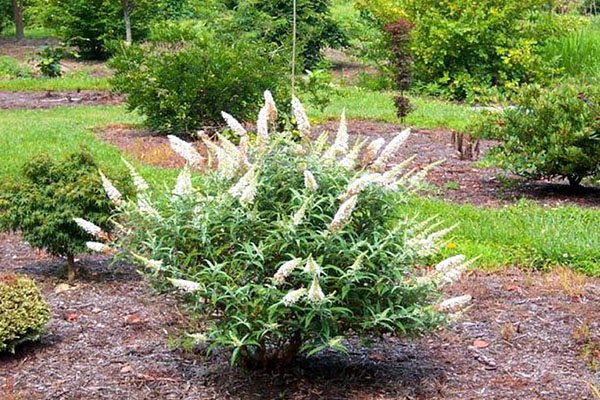

Choose places for planting budleia bushes should be sunny and protected from strong winds and drafts.
The plant prefers soil that is moist and well fertilized.
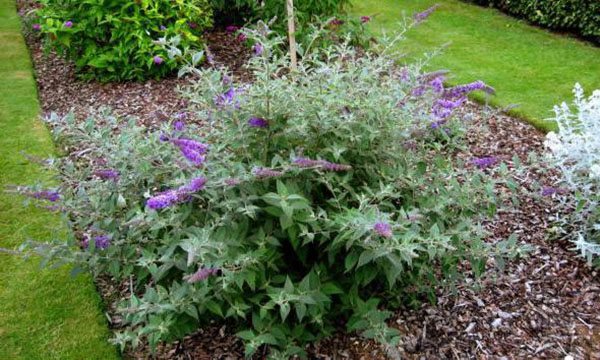

The distance between budleia bushes should be large enough (approximately 1-1.5 meters), as the plant grows rapidly.
When planting and nursing outdoors, the budley should be pruned regularly. In the first year after planting, young shoots are cut to half. The next year, the newly regrown stems are pruned. It is recommended to leave 2 kidneys on them.
Pruning not only helps to shape the bush, it promotes longer plant life and stimulates active flowering.
How to care for buddleya in the fall and prepare for winter: pruning and sheltering
Buddleya is one of the most unpretentious shrubs that blooms from July to November, i.e. almost all summer and autumn. Covering itself with long and lush buds, it emits a divine honey scent that attracts butterflies to the garden.
However, despite all the unpretentiousness of the "autumn lilac", every year at the end of the growing season it needs some preparation for winter, namely pruning and shelter. Read on to learn how to care for and properly prepare a buddley for winter.
By far the most popular variety is David's buddley (also called volatile). The fact is that it is most suitable for growing in the conditions of the Central strip (Moscow region) and in other regions of Russia. However, there are also other types of buddleia: globular, alternate-leaved, white-flowered, snowy and Japanese.
Frost-resistant budley varieties
Budleya is called "oriental beauty" for a reason. The countries of warm latitudes are considered its homeland, so it is not surprising that the plant feels most comfortable in the southern regions. However, it is also quite possible to grow a budley in a summer cottage in the Russian climate with proper care and proper attention.
Since buddleya has gained popularity far beyond the subtropical zone, breeders regularly develop new varieties that can delight the eyes of those who live in less hospitable climates.
The most frost-resistant plant varieties include:
- Buddley David in particular Empire Blue, White Profusion, Pink Delight and Royal Red varieties;
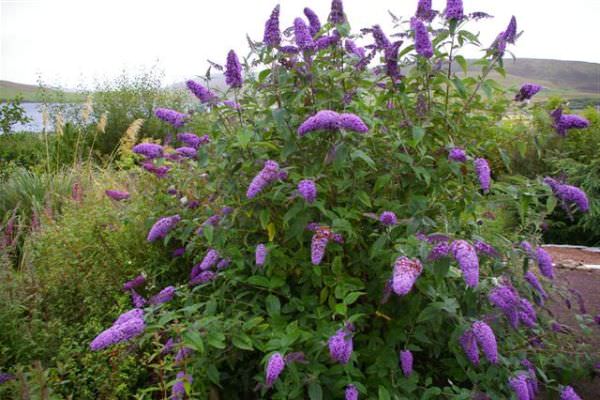

- Budley Vich;
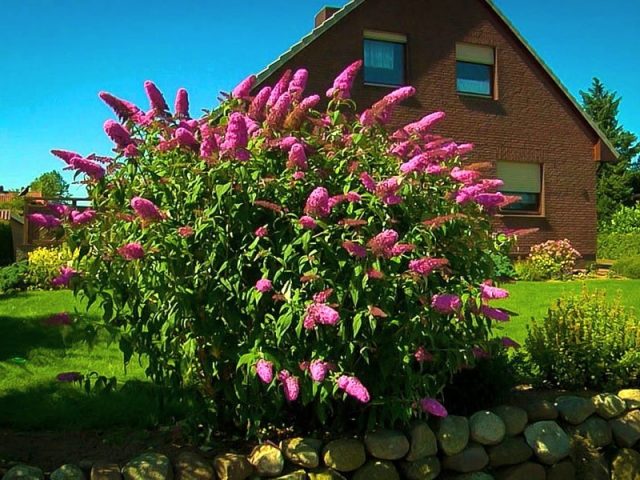

- Budley Wilson.
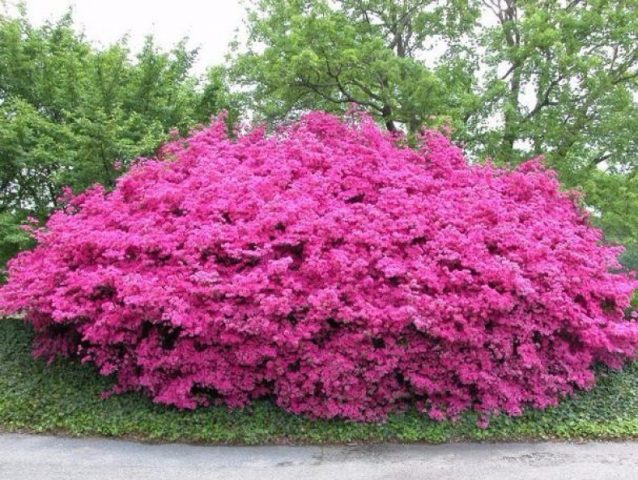

They are able to withstand frosts down to -23 ° C.
In addition, among the variety of species, representatives with an average winter hardiness are distinguished, including:
- Japanese Budleya;
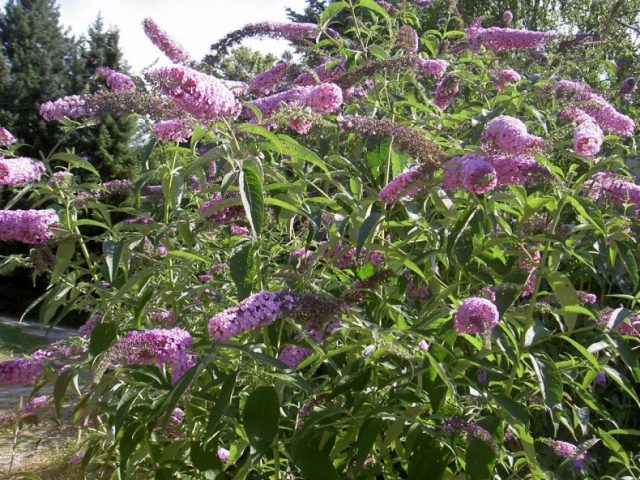

- White-flowered budley.
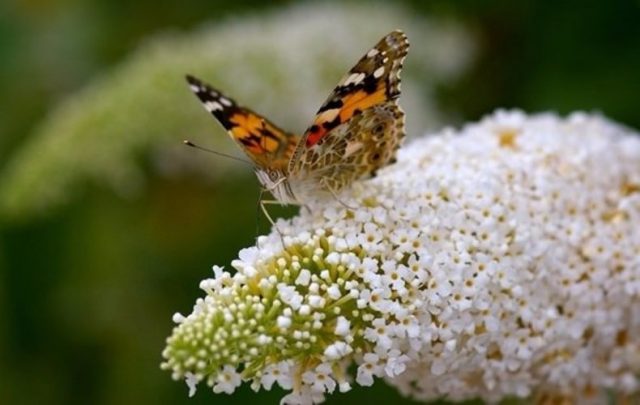

How to care for buddleya in the fall to properly prepare for winter
Here are the activities that are usually included in the fall care and preparation of the buddleya for winter:
Before and during flowering, the bush will need potash and phosphorus fertilizers (for example, you can use potassium sulfate and superphosphate or wood ash and bone meal).
Also, in the fall, before wintering, you can mulch the bushes with compost or sprinkle with humus. In this case, you do not even have to do the spring nitrogen fertilization of the shrub.
- Pruning (faded inflorescences and shoots for the winter).
Advice! During the fall pruning, you can cut your own cuttings for further buddley propagation.
About, how to grow a buddley from a cutting, read more in in the material on planting and growing this flowering shrub.
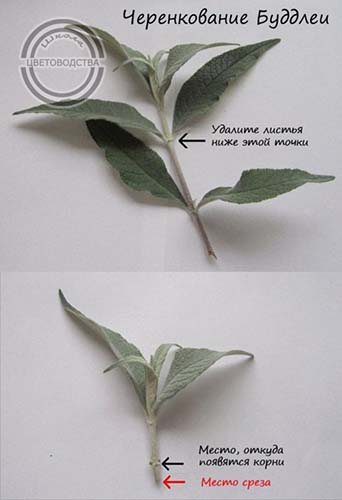

- Moisture-charging irrigation.
- Shelter for the winter and mulching.
Budleia transplant in autumn
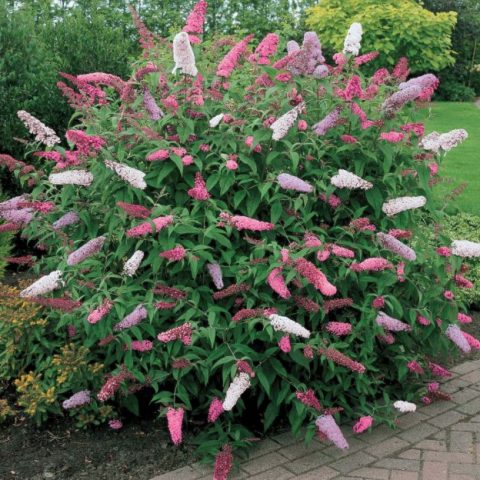

Despite the fact that the budlea is quite unpretentious to care for, this plant is difficult for transplants, since its taproot is deep in the ground, its extraction can injure the root system of the bush. However, sooner or later it may be necessary to transplant the budley to a new place, and the optimal time for this is the spring period before the start of the growing season, when the risk of sudden frosts is minimal and the soil is sufficiently warmed up.
In the fall, budley is transplanted only in extreme cases. At this time, the chances that the plant will take root are very low, even with proper care. If in the autumn time it is transplanted into open ground, it is highly likely that the shrub will not survive the winter months, since it simply will not have time to gain a foothold in a new area. Therefore, if possible, it is worth postponing the procedure until a more appropriate time. In the event that an autumn buddlea transplant is unavoidable, the plant should be provided with proper care for a successful wintering.
Pruning buddleya in summer and fall: when and how to prune
Summer pruning of peduncles
If you promptly remove old faded inflorescences, then due to this, other lateral flower buds will immediately begin to wake up in the sinuses and the buddley bush will bloom profusely without ceasing, without losing its decorative effect for a day.
Video: pruning buddleya of David during flowering
Autumn pruning for the winter
Note! In the southern regions, there is no need to prune the buddley for the winter, because it winters well without any shelter.
Pruning buddley for the winter is very simple: you just need to cut all the branches almost to the ground (they also say "to the stump"), i.e. 5-10 cm (sometimes it is advised to leave 15-20 cm), i.e. remove all vegetative part.
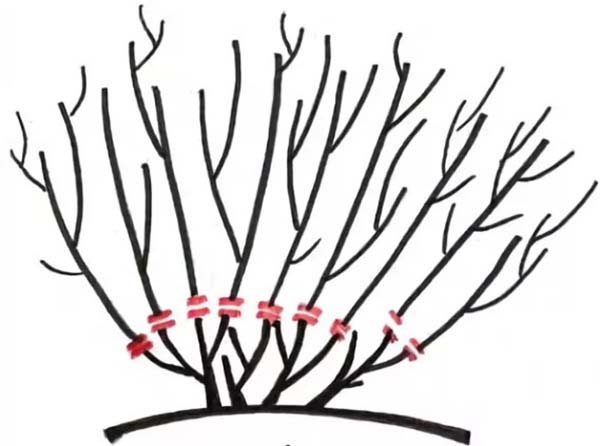

Video: how to crop buddley for the winter
But! Since the entire above-ground part (shoots) of the shrub completely freezes in winter, and with the arrival of heat (spring), the plant forms a new growth from scratch, which by summer increases its green mass (and then blooms on the shoots of the current year), then you, in principle, , you may not prune in the fall, but do it in the spring.
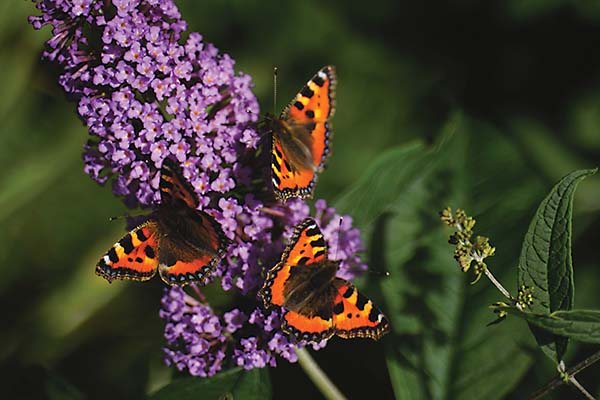

Reproduction of budley cuttings in autumn
People who have previously dealt with the cultivation of budley know that it reproduces intensively both by cuttings and with the help of seeds. However, in the Russian climate, even with proper care, it is not always possible to grow budley seeds with seeds, and therefore the second breeding option is widespread in this territory.
For grafting budlea, planting material is harvested in the fall, during the autumn pruning of the shrub. Cuttings are best made from one-year-old branches of the plant, cutting them off at an angle of 45 °.
Cuttings are planted with the onset of spring or in the autumn months after the end of pruning.
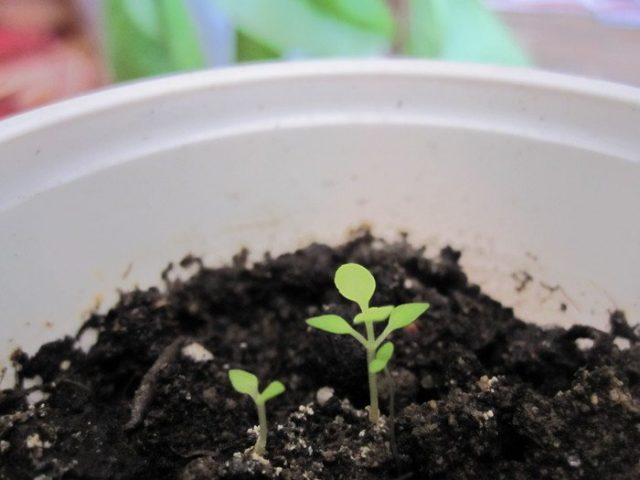

Autumn planting of a plant is carried out according to the following algorithm:
- Shrub cuttings are placed for 5 - 10 hours in a solution of Kornevin or Heteroauxin.
- Depressions are made in loose soil and watered abundantly.
- Then budlea shoots are placed inside by 3 - 4 cm.The distance between them should be 1.5 - 2 m.
- After that, the cuttings of the plant are covered with plastic bottles wrapped in polyethylene, and left until spring.
Shelter buddleya for the winter: how to keep the bush until spring
Buddleya is a slightly frost-resistant plant, so she definitely needs shelter for the winter in most regions (except for the southern ones).
Even the most frost-resistant varieties can withstand frosts up to a maximum of -20 degrees.
The shelter is made only after a stable subzero temperature is established (-2 ..- 3).
You can cover the buddley for the winter in one of the following ways:
- Slightly spud the bush with humus or peat, and also mulch with leaves (in this case the bushes can not be cut off for the winter, but transferred to the spring).
- Do everything the same, and install a wooden frame on top and, plus, cover with spruce branches (Autumn pruning is a must!).
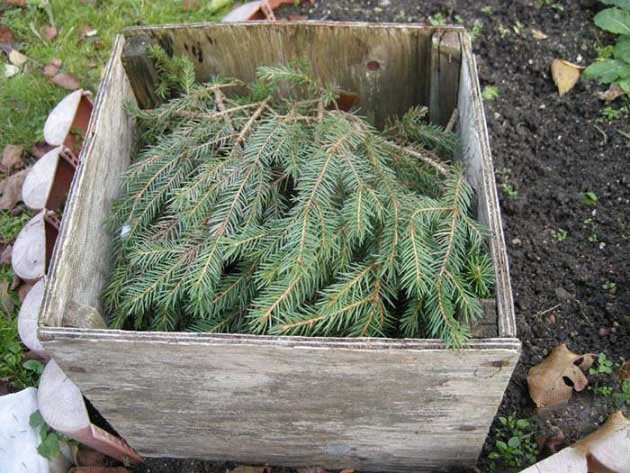

- Or cover with a wooden or cardboard box, setting arcs on which to stretch the spunbond (Again need pruning for the winter!).
By the way! And if you live in a region where permanent snowy winters (for example, in Krasnoyarsk), then the buddley, sheltered thick layer of snow (1-1.5 meters), it will perfectly be able to winter and without any other shelter (but with cropping!).
In very cold regions, it is better not to leave the buddley to winter in the open field, but to transplant it into a greenhouse, basement or cellar.
This is especially true for young 1-2 year old bushes, which must be dug up together with an earthen clod at the end of autumn, placed in a container and transferred to the basement for the winter.
However, buddleya is so good that it is able to quickly recover after winter and begin to bloom on the shoots of this year.
Note! But if you do not cover it correctly or do not cover it at all (relying on a snowy winter, but it will not be), a buddley (especially a young one) can freeze completely (its roots will perish).
Video: how to cover a buddley for the winter
How to cover a budley for the winter
Since most types of budlei are thermophilic, winter for such shrubs is a very harsh time. How the plant is prepared for wintering directly depends on its well-being and further flowering.
Tender young shrubs that have not reached 2 - 3 years of age especially suffer from temperature changes, since they are most prone to freezing in the area of the lower branches. But if the temperature indicators do not fall below 5 - 10 ° C, then there is a possibility that with the arrival of spring, young budleys will recover quickly enough. In more severe frosts, the shoots will hardly grow green mass and will bloom weakly.
To avoid this and ensure a successful wintering for the budley, it is worth taking care of proper care for them in the fall, having built a shelter from frost:
- First, a special frame is made with a length of about 20 - 25 cm. It can be made of wood or wire mesh.
- It is then wrapped in a waterproof cloth or other water-resistant material such as polyethylene or roofing felt.
- After that, the frame is carefully fixed with stones from all sides so that it is not blown away by the wind.
- Dry foliage or hay is placed inside the structure. To cover the budley in a climate with slushy autumn and mild winters, in no case should you use film or sawdust, otherwise the shrub will rot under such a shelter.
Pruning in the fall
In order to enjoy the regular and abundant flowering, buddleya must be pruned in time. In addition, there are a number of reasons confirming the feasibility of this procedure:
- Aesthetic aspect. The branches of an unkempt plant are strongly elongated. Because of this, the shape of the shrub loses its presentability.
- Immunity. Regular pruning of the branches stimulates the budlea's resistance to environmental factors and diseases.
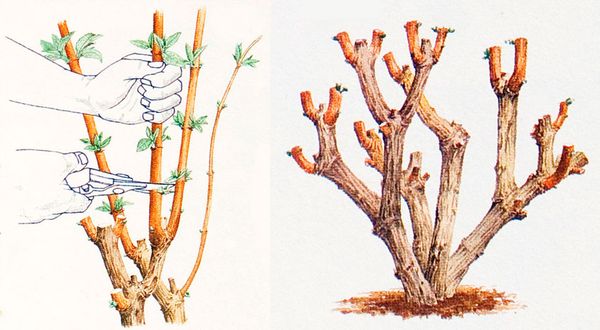

Pruning dates in most cases fall in October-November. The main guideline for the gardener will be the blackening of the leaves of the shrub. In order for the autumn pruning to bring the maximum benefit to the shrub, it is necessary to understand the technical aspects of its implementation.
Autumn pruning is carried out in two stages:
- removal of inflorescences after flowering;
- shortening shoots.
As a result of the procedure, the height of budleia branches should not exceed 25 cm, which will have a positive effect on its spring development. After pruning, the plant is not fed, but systematically hilled. The plant is fertilized with potassium-phosphorus mixtures in early July - this activates the growing season and supplies the bush with the nutrients necessary for abundant flowering.
Plant propagation by cuttings
Very often they ask the question of how to properly propagate plants by cuttings , especially novice gardeners.
Shank is called the useful part of the plant, separated from the main part for subsequent reproduction by a vegetative method.
Cuttings - a fast and efficient way of propagation, in this way you can easily increase the stock of your favorite plants.
Exists three main types of cuttings , each of which is cut at a specific time of the year, in varying degrees of plant maturity. These are softwood cuttings that produce green plants, semi-lignified and lignified cuttings.
Before starting work, you need to observe some simple rules for grafting :
- make sure the plant is healthy before cutting the cutting and use only clean tools;
- to prevent the cuttings from drying out, protect them from direct sunlight;
- Slip a plastic bag over the pot to create a moist atmosphere for the young cuttings.
Cutting softwood plants
Softwood plants include:
Softwood cuttings root well but die easily, so store as above. Slice them early in the morning while it's still cool. Choose live, vigorous, non-flowering shoots with three to five pairs of leaves. It is better to cut the shoot under the internode.
Cuttings should be 7-10 cm long.
When doing this, remove the buds and cut off the lowest pair of leaves.
Cover the pot with a plastic bag to help maintain constant moisture and improve germination.
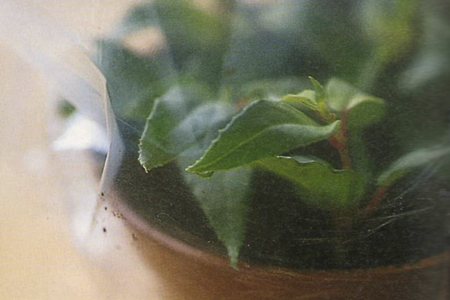

Place the pot in a warm, bright place, but avoid direct sunlight. Cuttings should be checked regularly and moisture added as needed. When new shoots appear, the film can be removed and eventually transplanted into open ground.
Semi-lignified cuttings
In this way, such plants are cuttings as:
Consider at example juniper cuttings .
It is better to do this in the second half of summer - the beginning of autumn, since it is at this time that they take root better. To do this, select healthy shoots that have begun to turn brown and woody at the base.
This is done as follows: gently tear off the stalk from the parent plant so that a small thin strip of bark is formed - the "heel".
Use a sharp, clean knife to cut the stem just below the internode so that the cuttings are approximately 7.5-15 cm long. Cut off the cuttings with the "heel" from the extra branches. To reduce water loss on bushes with large leaves, cut the leaves in half.
In order to achieve rapid rooting, remove a 2 cm long strip of bark from one side of the base of the cutting (Fig. 1).
Dip the prepared cuttings into rooting powder, shake off excess and insert them into a 7.5 cm pot filled with fresh compost for planting seeds or cuttings, close to the edge.
Follow the instructions from step 2 and onwards for softwood cuttings.
Lignified cuttings
Currants, forsythia, honeysuckle, jasmine, mock orange, willow, spirea, poplar - for the propagation of these plants it is better to take woody cuttings that grew during the summer.
For best results, cut the cuttings as soon as the leaves are flying off the deciduous plants. The stems should be healthy, pencil-thick. Length approx. 15-30 cm. Use pruning shears to cut them, cutting the shoot just below the bud at the base of the plants and just above the bud at the top. Make the upper cut at an angle so that it gets rid of the water sooner, thus it will be easier to determine the top of the plant.
In evergreen cuttings, you need to remove the leaves, leaving only 3 or 4 leaves on top.
Choose a protected but sunny location with well-draining soil. Use a shovel to dig a narrow wedge-shaped ditch approximately 20 cm deep. Fill the base of the ditch with sand, then stick the cuttings into the sand 7.5 cm apart, leaving one third of each cut above the base of the earth. Fill the ditch with soil and compact each stalk well. Water during dry periods and remove weeds.
Winter shelter
How to cover a budley for the winter is a question that worries many novice gardeners. And it is not in vain, because the shelter of the bush is considered one of the most important aspects of care. There is no specific deadline for preparing insulation for the winter.You need to be guided by the peculiarities of the budley variety and the region of residence.
It is possible to cover the shrub only after the cold weather is established on the street. Otherwise, the branches, and with them the root system of the budley, can rot from excess moisture. Shrub seedlings that are not yet frost resistant are recommended to be dug up and stored in the basement.
Adult plants are insulated by the following methods:
- In northern latitudes, budley is insulated by creating a kind of slate case around the trunk. First, the trunk is covered with a thick layer of dry soil. Then, on top of the soil, a structure of a suitable size is installed, like a box, and covered with slate or roofing material. Sawdust, polyethylene and other heat-insulating materials are unacceptable, as they will inevitably lead to rotting of the root zone of the bush.
- For regions with severe winters, the method of building a greenhouse is relevant. The trunk of the budley is covered with soil, and the root area is mulched with manure or peat. Arcs are installed along the perimeter, onto which agrotextiles or film are pulled. For additional protection from frost, dry leaves or straw are spread over the greenhouse.
Features of growing buddley
The shrub is capable of blooming for 10 years. A feature of some types of buddleya is the ability to set fruits. They are capsules with numerous seeds.
The nuances of growing a shrub:
- in regions with severe weather conditions, buddlea shoots freeze slightly, but the plant quickly recovers, giving new branches in the summer;
- fast-growing shrub;
- care requirements vary depending on the cultivated variety (amount of watering and dressing, preparation for winter).
The plant produces profuse flower stalks that attract attention with their honey aroma.
When buddleya blooms
The flowering period lasts from July to October and may vary slightly depending on the region where the plant is grown.
The first buddlea flowers can be seen both at 1-2 years of planting and at 3 years of age. It depends on the grooming and planting method. Weakened plants have few buds, they wither quickly.
Regional distinctive features
The method of insulating a shrub directly depends on the climatic characteristics of a particular region. In Siberia and the Urals, many gardeners use sawdust as organic insulation. They are poured on top of a plant cut and covered with a special material. The disadvantage of this method is the ability of sawdust to absorb moisture, which often causes decay and death of autumn lilacs.
In the suburbs, where winters are relatively mild, a kind of greenhouse made of polyethylene is being built over the budley. This is more than enough for a comfortable wintering of the plant. Residents of the Volga region install a greenhouse, on top of which a thick layer of mulch is distributed, which provides a high level of thermal insulation.
How buddleya reproduces
The method of growing the shrub depends on the region of residence. In countries with warm climates, it is possible to propagate buddlei varieties by seeds. This is a laborious process that requires preliminary preparation and takes a long time.
The most common and less costly way to propagate buddlei varieties on the site is to harvest apical cuttings. They are obtained by cutting, followed by rooting of the shoots.
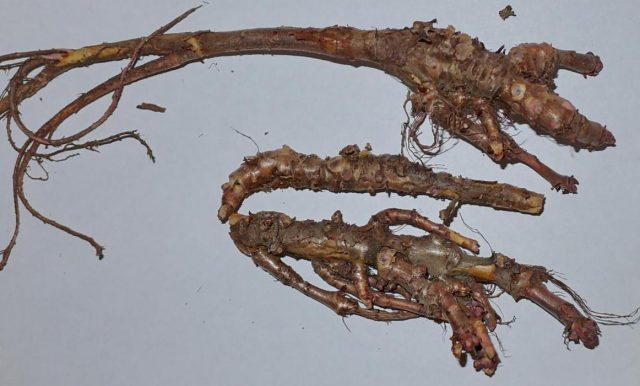

Frost-resistant varieties
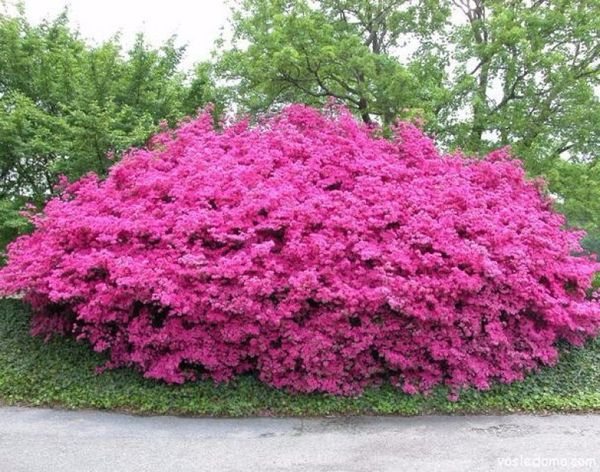

There are frost-resistant varieties that perfectly tolerate winter without any additional insulation. They can be grown even in severe frost conditions. These include budleys:
Novice growers often make a number of mistakes that negatively affect even such a resistant plant. Among them:
- early warming, which is fraught with decay of the root system;
- dressing made under the bush in the fall;
- belated opening of budley in spring, as a result of which the plant rot.
Many summer residents give their preference to wooded shrubs. It is famous for its enchanting autumn bloom and honey notes in the aroma.
The flowering period, by the way, is much longer for Budleia than for other horticultural crops. Its unpretentious advantage is its unpretentiousness - many varieties of plants perfectly tolerate both summer drought and frost in the cold season. The gardener can only take care of her wintering: prepare the plant itself and a cozy shelter for it. A responsible and patient grower will certainly be rewarded with the lush and fragrant flowering of this shrub.
How to grow a budley from seeds
How quickly the shrub blooms depends on the quality of the seedlings. When using this method of propagation, flowers can often be seen only for 2-3 years of life.
Growing buddleys from seeds is also possible at home: seedlings are collected independently or purchased in horticultural centers.
What budley seeds look like
The seed material of a plant is like dust, very fine. Often planting buddleys from seeds is difficult: they do not have time to ripen due to a long flowering period.
This leads to a decrease in varietal qualities and poor germination of the material. In regions where summer is short and autumn is cold, purchased seeds are preferred for growing buddlei varieties.
Bright budley in the garden Bookmark 32
Budleya (Buddleya)
Buddleya won the love of gardeners thanks to the decorative crown, abundant and long flowering, the wonderful honey aroma of numerous flowers, writes P.S. Kiselev.
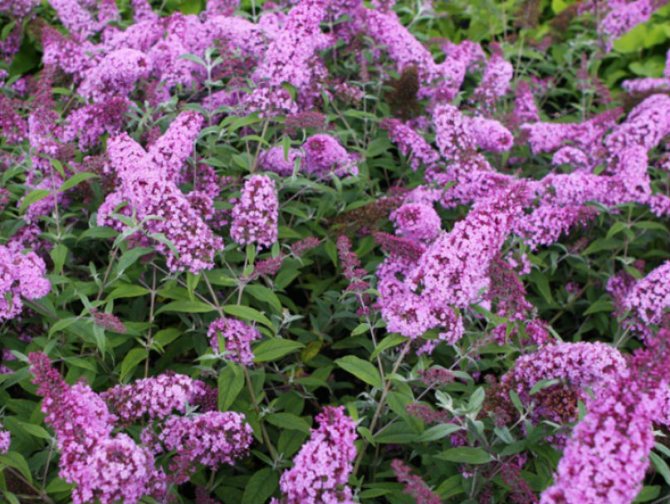

When buddleya blooms, many different pollinating insects flock to its fragrant bush, including a huge number of elegant butterflies.
Therefore, buddleya is often called "paradise for butterflies", "butterfly bush", "bush magnet for butterflies." And since buddley flower stalks with numerous small flowers appear on the plant in the fall and resemble in their structure lilac panicles, the buddleya is also called "autumn lilac". Types, garden forms and varieties of buddley.
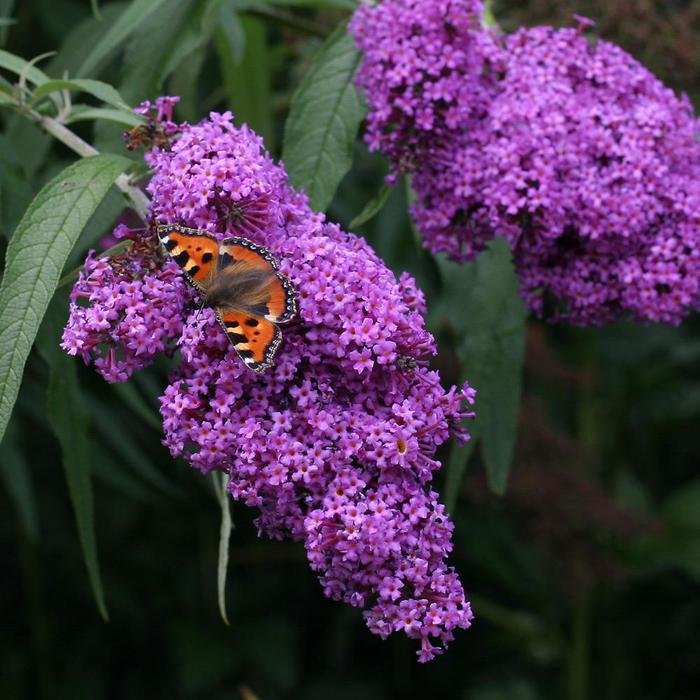

Comparatively winter-hardy and the most spectacular types of buddlei have been introduced into culture, they are happily grown in gardens.
Russian gardeners in the middle lane are successfully cultivating hardy buddlei species that can withstand cold winters. In the south, there is a wider variety of species of these attractive plants.
Buddleya white-flowered (B. albiflora) is a deciduous shrub with white or pale lilac flowers. Small flowers are collected in large, broadly cone-shaped, erect inflorescences.
Snow buddleya (B. nivea) is a deciduous shrub with a strong tomentose pubescence of shoots, leaves and inflorescences. Lilac flowers are collected in small panicles, which develop at the ends of the shoots in several pieces.
Japanese buddleya (B. japonica) native to Japan, 2-3 m high. It is a deciduous, fast-growing shrub with sprawling tetrahedral shoots. Lavender flowers are collected at the ends of the shoots in dense drooping panicles up to 20 cm long.
Buddleya alternate-leaved (B. alternifolia) is native to northwestern China, where it grows in dry, open areas. This species develops especially well on chalky soils; it is resistant to drought. This deciduous, domed shrub has sprawling drooping shoots, reaching a height of about 3 m and the same width. With appropriate pruning, you can grow buddleya alternate-leaved in the form of a tree with a decorative "weeping" shape of the crown. During flowering in early summer, the long, slender shoots of the plant are covered with garlands of small inflorescences made up of tiny mauve or lilac almond-scented flowers. Unlike other species, buddleia has an alternate-leaved superficial root system, and flower buds are laid on shoots of past years.
Therefore, when a bush freezes or when grown in a windy place, the flowering of this vulnerable plant is poor or absent altogether.
Spherical buddleya (B. globosa) is a semi-evergreen shrub that blooms in May with round orange-yellow heads of inflorescences. Due to the thermophilicity of this species, its cultivation is recommended for the south of Russia and regions with warm winters. As a rule, buddleys with spike-shaped inflorescences are bred in our area, which are more hardy than alternate-leaved, spherical and other buddleys. In the Moscow region, I grow only David's buddley, which is more unpretentious compared to other species and is very popular with gardeners. Buddleya David, or buddleya volatile (B. davidii Franch.) Is native to China, where it grows along the banks of streams, among bushes, in low mountains. This species develops and blooms better on calcareous soil.
Buddleya David is a deciduous shrub up to 3 m tall or a small tree (up to 5 m) with broadly spreading branches. Narrow leaves are pubescent below. Numerous flowers (up to 1.5 cm in diameter) are collected in dense inflorescences (up to 50 cm long), erect or slightly drooping.
Due to the high growth rate, the abundance of large foliage and heavy inflorescences at the ends of the shoots, the rather thin branches of David's buddleya diverge to the sides and droop.
Planting and caring for budlei outdoors
Cultivation of David's buddley is possible in greenhouses, greenhouses or open field. The growth rate of the seedling and its adaptability to environmental conditions depend on the time of planting and subsequent care.
It is recommended to place buddlei varieties away from trees and tall shrubs: the plant has a strong root system that can prevent neighbors from bearing fruit and growing.
When to plant budley in spring
Planting with subsequent care for David's buddle is carried out in the first half of July, when the daytime air temperature slightly differs from the nighttime.
It is allowed to transfer a shrub seedling in early June, but the process requires the organization of frost protection with material or plastic bottles.
Where to plant a budley
The branches of Buddleya continue to develop throughout the summer and autumn, until frosts come, therefore, to prevent their death, a sunny site is chosen. It is necessary to protect plantings from strong winds.
The soil for the shrub must be fertile, moisture-permeable and well-drained. In clay soil, the plant dies quickly or grows poorly. For the enrichment of heavy soil, peat or sand, humus are used.
How to plant
When planting several bushes, it is necessary to mark the site so that there is at least 1-1.5 m between the plants, and if these are tall varieties, then 2-3 m.
Basic principles of planting:
- prepare holes with a depth of 20-30 cm, fill their bottom with humus, add 1 glass of ash;
- transfer the seedling into a pit, sprinkle it with earth.
At the end of the procedure, bumpers of the earth are formed around the budlea and the soil is plentifully watered with warm water.
Budley secrets
It is very important for every grower to pay attention to the following:
- budley will always look beautiful in a group planting, or against the background of a lawn;
- an excellent solution would be to plant three or four bushes of different sizes;
- planting this flower with other flowering shrubs is acceptable to create a contrast in color;
- Budley goes well with garden roses;
- Budley looks great along with ground cover plants, as a dominant in the garden landscape;
- it is possible to grow budlei in flower pots;
- this plant tolerates pruning well during the formation of a bush;
- blooming budley is an excellent honey plant;
- the flower is pollinated by butterflies, so these multi-colored insects will always flutter over its petals.
It is also necessary to take into account that among the species of this plant there are both tall shrubs and compact ones.
Closing instruction
When making and installing the frame with your own hands, all materials and inventory should be prepared in advance. In the course of work, you will certainly need a saw or jigsaw, a hacksaw for cutting metal, a drill or screwdriver, screws, scissors, twine or flexible plastic fasteners.
Implementation techniques
When deciding on the method of shelter, you need to take into account the age of the shrub, its volume, as well as belonging to the species. Consider a few easy-to-implement options:
- A tent in the form of a wigwam 15–20 cm higher than the plant itself is constructed from 3 bars or pieces of reinforcement. The cover is pulled over the frame so that the bottom lies on the ground. The edges of the cover are fixed with bricks or stones and covered with earth.
- An arc frame with several wire crossbars is constructed from plastic arcs or thick wire. Insulation is thrown over it, tied at the top, and the bottom is pressed with bricks.
- An inclined fence is installed from a metal mesh, on top of which insulation is laid and fixed.
- A quadrangular frame with an inclined roof is made from beams or reinforcement. The top is covered with plywood, and the sides with any insulation. This is a convenient option for low-growing bushes.
Buddleya David planting, growing and care
If you plant a bush in a harsh frosty climate, it can freeze, but Buddley David has a wonderful property to recover, growing new shoots in June. It grows very quickly and grows up to 70 cm in height in a few months, blooms very beautifully from July to October.
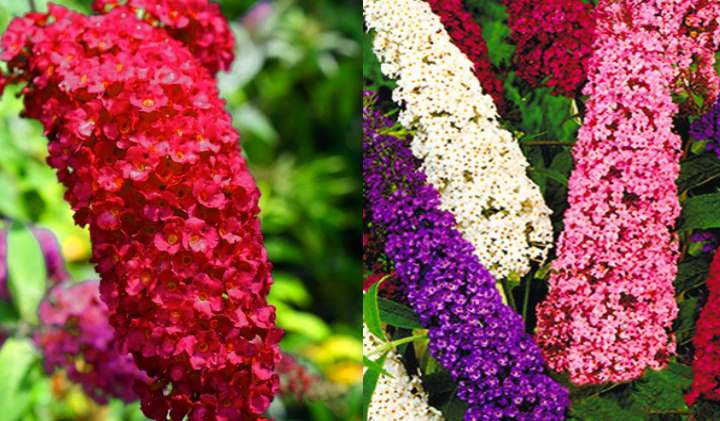

The standard color of the inflorescences is lilac, but breeders have developed new, no less beautiful varieties, such as:
- Alba (Nanho Alba) - White Buddleya of David blooms in July-October,
- Royal red (Royal Red) - Buddley of David with purple-red inflorescences, the most fragrant of the subspecies,
- Orchid beauty (Orchid Beauty) - pale lilac flowers bloom from August to September,
- Harlequin (Harlequin) purple color of peduncles,
- Black knight (Black Knight) almost black (dark dark purple) ears of flowers,
- Flower power (Flower Power) - purple with orange, blooms for a month and a half and many other varieties.
Interesting! The cells of this plant are used as an antiseptic in cosmetology.
Planting Buddley David
It is very important to choose the right planting site for the shrub - the growth rate of Buddley David and its decorative appearance will depend on this.
It is advisable to find a place where a number of conditions will be observed: sunny - Buddleya David loves sunlight very much, spacious - so that the branches of the bush can grow and develop freely, protected from the wind - the branches are rather fragile and can break in strong winds.
The soil of Buddley David loves loose, without stagnant water. It is better to prepare the ground before planting by adding peat to it, making drainage. After planting around the bush, cover the ground with grass. On a note! In the homeland of Buddley David, it grows up to fifty years, but in northern latitudes only five, so if you like this plant, you need to take care of the renewal of the shrub in advance.
Reproduction of Buddley David
The most popular and effective methods are growing Buddley David from seeds and propagation by cuttings. The most common and easy method is grafting, and it is also suitable for the novice gardener.
For plant propagation by cuttings, the time is suitable from mid-summer to autumn. You need to choose healthy and beautiful shoots, they should be green, not lignified, have two internodes. It is necessary to cut the cuttings, treat with heteroauxin and plant in a pot of sand and cover with a jar, if the cuttings are placed in a cool place. Spray with water several times during the day. You can plant a cutting immediately and permanently in the garden. All plants of Buddley David, both adults and young ones, need to be covered for the winter.
After flowering, Buddley David gives many seeds from which new bushes can be grown.To do this, the seeds must be sown in January in a pot with soil, in which there must be at least 25% peat) and watered first only from the pallet. Crops should stand in a warm place and be covered with glass or foil. Periodically, the film or glass must be removed to ventilate the air under it. From time to time, you can water with a weak solution of manganese to prevent the occurrence of "black leg" rot.
It is necessary to plant the sprouted seedlings after four to five leaves have already appeared on it. When planting, fertilize with weak fertilizing solutions. It is good to temper the grown seedlings - put them on the balcony during the daytime, but protect them from drafts. When young plants become strong and confident, feel free to plant handsome men in open ground.
In the same year, the plant can grow to an adult state (70 cm from the ground), but not necessarily bloom. For the winter, the bushes are cut off, leaving 30 cm above the ground, huddled and covered). The insulation is removed in May, in June you need to feed the bush with bird droppings.
Important! If propagated by seed, the plant may mutate. When propagated by cuttings, the young plant fully retains the characteristics of the mother plant.
The bushes of Buddley David grow rather quickly, therefore, when planting seedlings, you must maintain a distance of at least two meters. If it is crowded, then the plant will receive less sunlight and will feel worse.
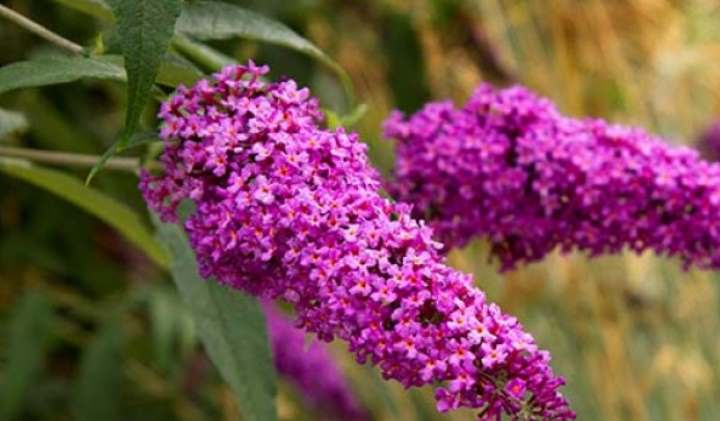

Watering Buddley David
The shrub loves frequent watering, but has a negative attitude towards the slightest stagnation of water. Spraying is also very fond of, but they should be carried out only in the early morning or late evening, when the sun is not so strong and there is no risk of burning the foliage.
During the growing season, Buddley David needs to be fed with nitrogen-containing fertilizers to recover from winter and grow quickly. The next time you need to fertilize the shrub is in the middle of summer, this time the fertilizer should contain phosphorus and potassium, which will ensure a lush and long flowering. Also, adding organic fertilizers such as wood ash, compost or humus to the soil will not be superfluous.
It is possible not to fertilize the plants at all, it will not die, but it will be frail, it may not begin to bloom.
Pruning Buddley David
During the summer, you need to remove faded buds for further abundant flowering. Pruning is done mainly in the fall to make it easier for the plant to survive the winter. In the spring, cut off weak branches and make a shaping haircut.
Important! Pruning is not only a formative, but also a prevention of infection procedure, since gray rot can easily appear on faded buds at high humidity.
Preparing Buddley David for wintering
The first thing to do in preparation for the winter for Buddley David is to drastically prune the bush. After pruning, ten centimeter branches should remain above the ground. A young buddleya in the northern regions is dug up for the winter, and left in the basement for storage. Only two or three summer houses spend the winter on the street.
It is necessary to make a canopy over the plant, placing arcs about 25 cm above the ground above it and cover the bush with dense polyethylene. An air cushion between the plant and the polyethylene creates a comfortable microclimate, the shoots do not rot. At the onset of the first frost, polyethylene should be sprinkled with leaves or covered with branches.
Further care
After the buddleya is transplanted to a new place, caring for it is not difficult. Now it needs to be watered thoroughly. The water should be settled and not very cold. It is good if watering is done in a small groove dug around the seedling. With this method of watering, the roots absorb water better.
Buddleya is a drought-resistant shrub, so there is often no need to water it. If the autumn is dry, the plant is watered only when the earthen lump has dried out. Before the onset of cold weather, the soil around the bush is thoroughly moistened.
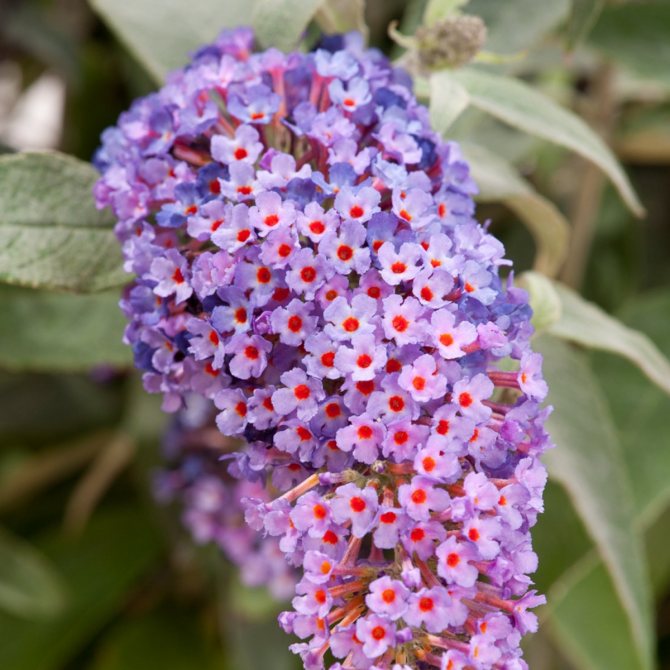

They feed the buddley several times a season.The shrub reacts well to the introduction of organic fertilizers. But in order for the plant to better prepare for wintering in the open field, from the end of July all feeding should be stopped. And when transplanting, it is better to apply fertilizers to the planting pits; rotted manure, ash and phosphorus-potassium fertilizers are perfect for this.
Description of the plant
Buddleya got its name from the English botanist Adam Buddle, who discovered this amazing plant in the 17th century. The shrub has about a hundred different species of a wide variety of colors and shades. The height, depending on the type, can be from 1.5 to 3 meters. The leaves on the stem are arranged in pairs. Small flowers are collected in lush panicle inflorescences, which are unusually fragrant.
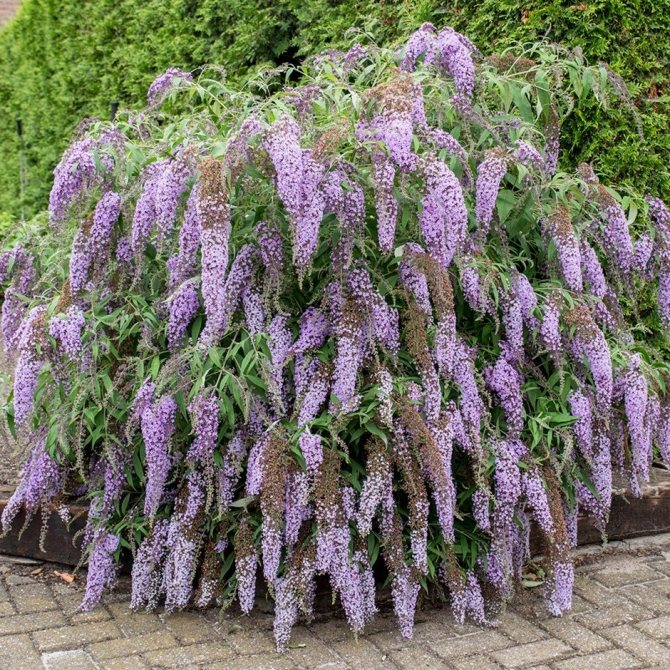

Photo: <>
Many butterflies, bees and other insects flock to the delicate honey scent, which is why the plant is called the "moth tree" and "butterfly magnet". Bright colors of this "autumn lilac" give the garden a special charm and give its beauty for two months. It is noteworthy that often on the bush at the same time you can see fruits, flowers and buds.
Choosing a landing site
After planting, the budley must be trimmed:
- remove weak and dry branches;
- shorten healthy shoots per bud by 1/3.
This is how skeletal branches are formed, which will give shape to the bush.
In the spring, immediately after awakening the buds, nitrogen fertilizers are applied. During the flowering period - phosphorus-potassium fertilizers or rotted manure with ash.
Budleia tolerates drought better than waterlogging, so watering should be moderate.
In extreme heat, it is required to moisten the crown of the bush. Budley blooms for several months. On the bush there are both flowering and fading clusters at the same time.
Removing wilting flowers will prolong the flowering of the bush and improve its decor.
Withered budleia flowers must be removed
According to the designers, planting a buddley in the Moscow region and subsequent care for it will not be difficult if the requirements of agricultural technology are met and frost-resistant varieties are selected. Budlea manages to bloom before the onset of frost, and there is enough time to prepare the plant for wintering.
The plant is planted in the spring, when the soil has warmed up to 180 C, approximately - the end of May or the beginning of June. In the spring, a seedling breeding method is recommended. Seeds are sown at the end of April, one month before placement in open ground.
Planting budlei in the fall in the suburbs is undesirable, the plant can leave in winter with a fragile root system. There is a great risk that Budleya will not overwinter. If necessary, an autumn planting, a well-rooted cutting or layering is taken, as an option, a seedling is purchased in a nursery. Work is carried out a month before frost, if the root system of the planting material is well developed, it will successfully take root and overwinter.
The plant is light-loving, it is much easier to tolerate an excess of ultraviolet radiation than its deficiency. The site is chosen open, protected from the north wind. The composition of the soil is chosen without excess moisture, loose, neutral, fertile. If the soil is clayey, sand is added, and the sandy one is mixed with humus, the acidic composition is neutralized with lime or dolomite flour. The site is dug up, the roots of the weeds are removed. Work is carried out 14 days before planting the seedling.
A successful wintering of a buddleya in the Moscow region depends on a properly carried out planting:
- Dig a landing hole with the expectation that it is 15-20 cm wider than the root, deepened by 50 cm.
- A drainage layer is placed on the bottom; for this purpose, pebbles, crushed stone or expanded clay are used, the layer is about 10 cm.
- Sod land is mixed with superphosphate - 50 g of the product for 8 kg of soil, poured onto the drainage.
- The budley seedling is placed in the center, the roots are distributed so that there is no interlacing, they are covered with earth.
- The soil is compacted, watered and mulched with peat or straw.
Attention! The root collar should be on the surface.
If the planting is group, the interval between the budleia bushes is 1 m.
Budlea is thermophilic and does not like drafts. It is from this that we must proceed in the first place. The segment of the territory in which the plant is supposed to be planted must be simultaneously sunny and sheltered from the wind. Therefore, the best place for a budley is along the fences (buildings), from their most illuminated side.
If the site does not meet these requirements, then the planting site will have to be specially prepared. Most often, a hole is torn off (approximately 35 x 35 cm), a drainage layer is poured into it (about 10 cm), and a prepared soil mixture is loaded from above.
We suggest that you familiarize yourself with: Do-it-yourself greenhouse for cucumbers: step-by-step instructions for building
Recommendations:
- Budleia does not like excess moisture. Therefore, the plant should not be planted in damp soil - when preparing it in this regard, one must observe the measure.
- When planting several budleia seedlings in a row, the distance between the roots is chosen approximately 40 - 50 cm (depending on the variety, the interval may be slightly different).
Should I plant in the fall
Planting, as well as replanting, buddleya can be both spring and autumn. In spring, the heat-loving shrub takes root much faster, since the growing season begins, and the viability of the plant is much higher. By planting it in open ground in the fall, you run the risk of ruining the oriental beauty. Therefore, if possible, postpone planting buddley until spring, or provide decent wintering conditions in the open field.
Can buddleya be propagated in autumn
Budleys reproduce both by seeds and cuttings. In Russia, due to the peculiarities of the climate, the seeds of an exotic shrub do not always have time to ripen, therefore cuttings are more common. Reproduction of buddley by cuttings is not a complicated process at all. In the fall, when the plant has faded, it is necessary to prepare planting material. For this, young annual twigs about 20 cm long are suitable, on which there are at least 3 buds (when planting, one bud remains on the surface, and 2 go deeper).
You can plant cuttings immediately after cutting, or you can leave them until spring. When planting in autumn, they need to be deepened into the prepared loose soil as mentioned above, watered and covered. They will move in growth in the spring. Before planting, cuttings are treated with heteroauxin. To hide the cuttings, plastic bottles or plastic wrap are perfect, thanks to which an air gap will appear.
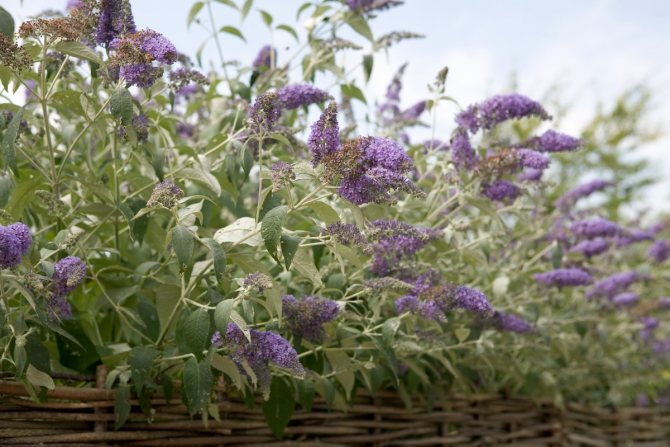

Photo:
Cuttings can be planted in containers, which are stored in a cool, frost-free room until spring. They need to be ventilated and watered as needed. When warmth comes, the cuttings are planted in a permanent place. It is not advisable to sow buddley seeds in autumn. Sowing is best done in late winter - early spring. To do this, it is necessary to moisten the prepared substrate (take equal parts of humus and sand), gently pour the seeds onto it, slightly covering them with soil. Many people advise not to sprinkle the seeds at all. Cover the top with foil or glass to create a greenhouse effect. It is better to germinate seeds on the windowsill, they need a lot of light. In 2-3 weeks (possibly later) shoots will appear. The main thing here is to ensure that the soil does not dry out, but stagnation of water should not be allowed either.
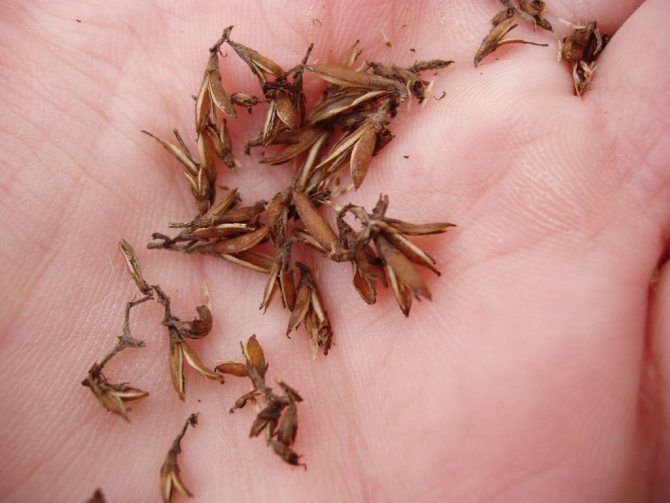

As soon as the first leaves appear, the protection is removed. The appearance of the third leaf is a signal to transplant the seedlings into peat cups. Young buddleys are planted in open ground in July. For the winter, a compulsory shelter is necessary, and in the spring they will actively move into growth. Buddleya is an ornamental shrub of amazing beauty. It will attract attention anywhere in the garden and will not get lost among other plants. Do not be afraid of his capricious nature, you just need to find an approach to him. And then the lush clusters of "autumn lilacs" will scent for a long time in your garden, and a lot of colorful butterflies will flutter over them.
General rules
Rhododendron, like many ornamental plants, lays flower buds for the coming year in the fall. The growing season begins shortly after flowering. All autumn the buds ripen to bloom in the spring and amaze with their splendor. The main task during this period is to make every effort so that the buds do not freeze in winter, and the plants remain in the same form in which they entered the winter.
They begin to cover shrubs no earlier than the daytime temperature drops below 3-5 ° C, and even then, only evergreens, which are more sensitive to cold. Deciduous and semi-evergreen species can be sheltered later when the temperature drops to -10 ° C. Rhododendrons are quite winter hardy, so there is no need to fear that they will freeze. Too early warming, on the contrary, is harmful to the bushes due to the fact that the root collar will begin to undermine.
The agricultural technology of the buddleya in the Moscow region does not differ from the care of the culture in the southern regions, with the exception of autumn preparation. To preserve the decorativeness of the plant, it must be fed, watered, and weeds removed from the site.
Budleya is drought-resistant, can do without watering for a long time. But it reacts badly to dry air, flowers and leaves turn yellow, then dry, frequent sprinkling is necessary. Watering is required for a young seedling to a greater extent. Activities are determined by seasonal precipitation. If it rained 2 times a week, this is enough for the seedling, but in dry weather the moisture deficit is supplemented by watering.
For an adult plant, one watering every 14 days is enough, the root system of a buddlea is superficial, a constantly moistened root circle can cause the development of a fungal infection. The climatic conditions in the Moscow region are unstable, a sharp change in temperature at night and during the day has a bad effect on the weekday if the soil is constantly wet.
Loosening the crop as weeds appear. Loosening is carried out in a thin layer so as not to damage the root. Top dressing is applied in spring, using superphosphate ("Kemira Universal"). Fertilize in autumn before preparing for wintering.
Pruning of the budleia is carried out in the fall, the crown is cut off completely, if conditions allow covering the budleia for the winter and not subjecting it to radical pruning. In the spring, frozen, weak branches are removed, the length of the shoots is shortened at will. Mulch budley immediately after planting and without fail in the fall.
How to prepare a buddley for winter:
The shrub resembles lilacs with its lush inflorescences, and because of this it received the name among the people "autumn lilac". Buddleya has a very pleasant and strong aroma, which is especially attractive to butterflies.
The most popular species from the more hardy plants are David's buddley (decorative forms - Wilson, Vich and varieties - "Nanho Purple", "Royal Red", "Pink Delight" and "White Profusion").
Less hardy species, suitable for the southern regions: Japanese buddleya, buddleya alternate-leaved and white-flowered buddleya.
Plants are planted in a permanent place only 2-3 years old. Until this moment, it is grown in containers with a soil mixture: sod land, sand and leafy earth (humus) in a ratio of 1: 2: 2.
YOUNG BUDDLEY
For the winter, the young bush is transferred to the basement (cellar), and in April-May it is taken out into the garden. At the end of June, it is fed with phosphorus-potassium fertilizers (ash). When the leaves begin to turn black on the bud, it is cut off at a level of 15-20 cm from the ground.
ADULT BUDDLEY
Adult bushes are watered abundantly in October-November and spud the next day. They sprinkle with dry soil, above the 3rd bud and cover with spruce branches, brushwood. Sometimes they additionally produce mulching with dry humus or peat.
Then a frame is made of iron arcs or a wooden box is taken, and the top is covered with slate, roofing felt or fiberglass.
- There are opposite opinions on the use of plastic wrap. Some gardeners recommend covering the arches or box with a double layer of film, and securing it tightly. It turns out a kind of greenhouse (greenhouse).Other experts advise against using film at all.
The editors of the Flower Festival magazine believe that if you make arcs at a height of 30 cm (40 cm - for severe winters) from the ground and fix the film well, then the resulting air layer will contribute to the successful wintering of the budley, and the plant itself will not rot.
To improve the effect, the resulting greenhouse is covered with dry hay or leaves after the onset of stable frosty weather -8-10 degrees.
Such preparation of the budley for winter allows the plant not to freeze even during a harsh winter. The further north you live, the more you increase the amount of covering materials and the height of the air cushion for a successful wintering.
- According to the observation of experienced flower growers, an important factor in successful wintering is the type of buddleia cultivation. A plant grown from seeds is much less likely to die in winter than a plant bought in pots.
Budley "Royal red"
Is it possible to grow a budley in a summer cottage?
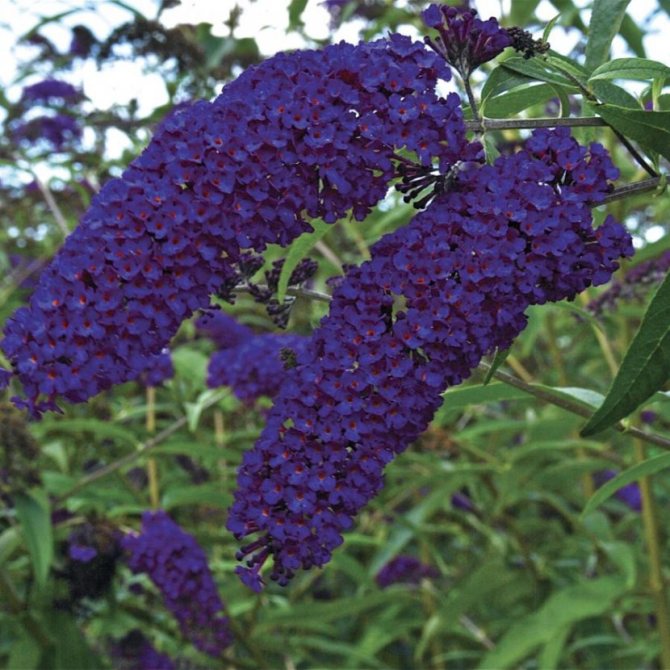

When planting a budley, one must remember to observe the conditions for planting and wintering the plant. Only in this case it is possible to grow a budleya in central Russia.
Disembarkation requirements:
- good lighting, no shading;
- lack of drafts and strong winds;
- without the possibility of waterlogging the soil.
In these cases, the bush gives a good growth of shoots and abundant flowering.
With proper care, budlea grows very bushy.
Training by area
As mentioned above, rhododendrons are quite winter-hardy, and many varieties in the temperate continental climate of the Moscow region or the Volga region can winter without shelter. Closer to spring, it is enough to simply shade them so that the wind and sun do not damage the shoots. Shelter is necessary only in those regions of the middle zone where thaws often occur in winter.
For northern regions with long and frosty winters, it is better to choose winter-hardy varieties, but they also need solid shelter. Evergreen shrubs, in addition to the frame and insulation of the roots, are recommended to be completely covered with foliage, straw, or to fill the space in the shelter with these materials.
Do I need to cover flowers for the winter and how?
Winter period with temperatures below 20 degrees will lead to freezing of the bush... To preserve the shoots, you need shelter for the period of cold weather.
Young bushes especially need to be insulated. They can freeze out. Mature plants are more hardy, but they also freeze under the autumn-winter cold.
Frost-damaged shoots are removed in spring. During the spring, the bush grows back and gains color on young twigs.
It is necessary to completely cover the budley: from root to top... For this, a frame is installed on which a double protective layer of material is stretched: insulating and water-windproof.
Bushes are cut for the winter:
- in the young, 3 buds are left above the soil (20 cm);
- 2-5 years old - by a third.
Warming methods
The frame can be metal, wooden. Polyethylene is suitable for protection from rain and wind. For insulation - any non-woven fabric.
A dry sheet is laid inside the protective device for better insulation and protection from excessive moisture.
Insulation in the form of straw, dry peat, leaf is laid on the base of the root. The whole structure is fixed to the ground with something heavy so that it will not be blown away by the wind.
In spring, the shelter is removed as soon as the temperature rises above -10 degrees. The root protection remains up to freezing temperatures.
Sawdust should not be used as filler in the protective device.
Pruning and feeding in the fall
Preparing shrubs for winter includes several activities, including pruning and fertilizing, which lay the foundation for a successful wintering. It is worth clarifying right away that these plants do not need formative pruning, since they have a genetically correct bush shape in 99%. Therefore, before wintering, only the removal of damaged shoots is carried out.
The only reason for pruning is to rejuvenate the bush.If it has lost its decorative effect and has ceased to bloom magnificently, then after flowering, the shoots are trimmed 2-3 cm above the level of dormant buds. After 2-3 weeks, the buds will grow, and by next year the decorative effect of the bush will be restored.
It is much more important to provide plants with food for the winter. To do this, a month before the onset of frost, somewhere in the middle of October, phosphorus-potassium mixtures that do not contain nitrogen are introduced. It can be double superphosphate or separately potassium and phosphorus. In order not to burn the thin roots, the shrubs are pre-watered and fertilizers are applied to the wet soil.
The roots of rhododendrons are shallow and shallow, so they cannot stand drought and need watering throughout the fall. The more moisture they absorb, the easier they winter. This is especially important for evergreen varieties. For successful wintering, their leaves must be well saturated with moisture.
The preparation of flowering crops growing on the territory of the garden plot for winter begins in early autumn. The task of the summer resident is to properly prepare the plants for the upcoming cold weather. First, you need to remove the weeds, debris, fallen leaves and broken branches from the garden. The collected leaves and tops are sent to a composter for humus.
The next stage of autumn care for garden crops is water-charging irrigation. Some plants do not like excess moisture in the soil. Therefore, the need for water-charging irrigation must be determined by the weather: if the autumn turned out to be wet and rainy, the soil need not be moistened. According to the descriptions of varietal characteristics, most varieties of daylilies are undemanding to watering. This culture is capable of accumulating liquid in the pulp of the rhizome processes.
Autumn is the time to prune flowering perennial crops. With regard to pruning daylilies, this procedure is carried out on the eve of stable frosts or immediately after them. If you rush or, conversely, be late with pruning, the plant may die.
First of all, dry peduncles and leaves damaged by diseases or harmful insects are removed. The remaining foliage is cut at a height of 10-15 cm from the rhizome. It is recommended to use a sharp knife or garden pruner for work. Some gardeners prefer to break off foliage with their hands, but in the absence of these skills, the plant can be injured.
The most popular varieties for the Moscow region that tolerate frost well
Out of 160 varieties of shrubs, Budlei ordinary-leaved, David, Vich, Wilson, as well as Belotsvetkovaya and Snezhnaya have acclimatized in Russia.
We suggest that you familiarize yourself with: Cabbage grows at what temperature
David
Budleya David grows up to 2-3 m in the conditions of the Moscow region and the Urals. It has large two-colored leaves up to 20 cm in length and spike-shaped inflorescences (up to 40 cm).
The flowers are lilac, with a honey scent. The flowering period is from late July to September. Has varieties that differ in color of flowers:
- Alba, White Cloud, White Profusion - white;
- Empire Blue, Black Knight - purple tones;
- Harlequin, Royal Red - shades of red.
David Alba White Cloud Profusion Empire Blue Black Knight Harlequin Royal Red
Wilson
Wilson's Budley resembles a weeping willow. It blooms from mid-August to late September with lilac-pink inflorescences up to 75 cm.
Wilson
Budleya Vicha blooms in early August in large, rich pink inflorescences.
White-flowered
Budleya Belotsvetkova bush has pyramidal vertical inflorescences with small white flowers.
White-flowered
Snowy
At Budla Snow, leaves, branches and flowers are covered with the smallest thick hairs that resemble felt. Lilac inflorescences are small, paniculate.
The warm and light-loving plant can be grown in conditions of low winter temperatures and return frosts. A strong annual growth of shoots compensates for the freezing of the bush in winter.
Snowy
Proper planting and care, timely pruning and covering for the winter will create the right conditions for the growth and flowering of budleia.
Originally from South Africa, the plant is thermophilic and does not tolerate low ambient temperatures. Thanks to hybridization, new varieties of budlei were bred, which, according to gardeners, became possible to grow in the Moscow region. The culture is used in the design of sites. In temperate climates, Budleya David with spike-shaped sultans and its breeding varieties are widespread. Hybrids differ in color of flowers and height of shrubs, their agricultural technology is the same.
The most popular varieties of David's budley for the Moscow region:
- Budlea Flower Strength or Bicolor is a hybrid with a double color of flowers. They are divided into orange and dark purple. The bush grows up to 2 m, the crown is spreading, with stems drooping at the ends.
- Budleya Black Knight is a medium-sized shrub (up to 1.5 m) with silvery foliage, compact, the ends of the branches are lowered. Inflorescences are 30 cm long, consist of dark purple flowers with a lemon core.
- Budleya Blue Chip is a low-growing shrub 45 cm high, with a crown diameter of 85 cm. It has a long flowering period - from July to October. Spike-shaped inflorescences of bright blue color with a purple core.
- Budleya David Alba is a medium-sized shrub (1.3 m in height), spreading with drooping branches, large, white inflorescences.
The main Budleia varieties are less frost-resistant than hybrids. They are planted in the suburbs of the spherical budley with orange rounded inflorescences and the alternate-leaved budley, the culture is valued for its decorative appearance, but it requires more thorough preparation for winter.
Important! Frozen stems will quickly recover in spring, the main task is to preserve the root system.
Trimming budley
The maximum and annual pruning does not allow David's buddha to grow too much. Such a procedure constitutes the necessary care that this rose bush needs. The photo shows how much space this plant can take. Therefore, proper pruning makes this flower ideal even for a small garden. Cut off David's budley, up to 30 cm, in early spring. In order to get a tall bush, they are shortened to 90 cm. Also, annual pruning stimulates not only abundant flowering, but also the growth of young shoots. By trimming the plant, growers extend its life span.
total, today
loading ...
Things to Avoid
Often, novice gardeners choose the wrong time for pruning daylilies for winter. Pruning early will cause the plant to grow abundantly and emit new flower stalks. At the first frost, a perennial may die. Late pruning is dangerous because the flower does not have time to recover and prepare for a cold snap.
Autumn feeding of plants in the garden with nitrogen-containing preparations can lead to the death of flowering crops. Feeding on complex additives, which include ammonium nitrate, ammonium sulfate, sodium nitrate, ammonium water, urea, calcium cyanamide, ammonium sulfonitrate and other types of nitrogen fertilizers, the daylily begins to grow actively. At the same time, the blooming ornamental culture is weakening, which affects its winter hardiness.
Description of buddley
An ornamental shrub grows rather quickly. The culture produces a large mass of leaves, therefore it gives the impression of a rather strong and lush bush. Flexible, spreading stems, slightly curved or straight. The leaves are lanceolate, dark green with white pubescence on the underside of the leaf.
The ornamental shrub of David's buddley owes its invariable popularity among gardeners to its magnificent flowering, which lasts continuously from June to October and resembles bunches of lilacs. Numerous flowers with an intense sweet aroma are collected in long, dense paniculate or cylindrical inflorescences that appear on the tops of the current year's shoots.
Their characteristic feature is an orange "eye" in the middle of each flower. The length of the inflorescences, depending on the variety, is from 20 to 40 cm.
The buddley plant is an abundant honey plant, but the structure of its flowers does not allow the bees to penetrate inside and the function of pollination is performed by numerous butterflies, for which the culture in many countries is called the "butterfly bush" or "moth tree".
The color of flowers is presented in a wide range of shades of different intensities: white, blue, orange, yellow, red, purple or pink.
Varieties of buddleya David c photo
- "Black Knight", a relatively new variety that has gained great popularity due to the delightful large blue-purple inflorescences;
- buddlea "Black Knight" with straight shoots up to 2 meters in height. Dark purple flowers are collected in panicles 40 cm long;
Read also: How raspberries affect blood pressure
- low "Nanho Purple".
- "Ile-de-France" - a wide bush with drooping shoots up to 2.5 meters in height. The purple flowers are collected in very large, slightly curved panicles that can reach 50 cm in length.
Pink buddley group Pink "Pink Delight", "Pink Delight", "Peakeep", "Minpap", "Summer Beauty".
"Border Beauty" up to 1.5 m in height. The flowers are red-pink with a purple hue, fragrant, collected in a panicle about 30 cm long.
Buddleya "Royal Red" is an ornamental shrub with thin drooping shoots, up to 3 meters high. The length of red-pink inflorescences can reach up to 40 cm. The disadvantage of this variety is its much lower resistance to low temperatures.
Flower Power buddleya is one of the most beautiful ornamental shrubs for your garden with an unprecedented color combination: the blue buds that bloom turn to dark orange! Plant height is about 150 cm.
Extremely fragrant buddleya "Tricolor" with fantastic color of flowers in different shades.
Alba group with white blossoms: "Mir", "White Profusion", dwarf "Nanho Alba" and "White Swan" and others.
"Harlequin" is a variegated shrub up to 2-2.5 meters tall with creamy white and green leaves and dense purple inflorescences 30 cm long.
Buddley blue covers several varietal forms with different shades of flowers: "Papillon Blue", "Empire Blue", undersized "Nanho Blue" and many others.
In addition to David's budley, one more type of highly decorative should be noted - buddleja alternifolia, which in its shape resembles a small willow with weeping branches strewn with purple-violet, pink or lilac inflorescences almost along the entire length of the shoot.
Flowers are formed in the axils of leaves on the shoots of last year, so pruning should not be carried out in spring, but immediately after flowering.
Planting buddley in open ground
It is best to use seedlings with a closed root system, as they are less susceptible to damage and quickly adapt to a new place. These plants can be planted throughout the season, but open-rooted seedlings are only planted in October or early spring.
Before boarding David's beddleys, you need to determine the location. The shrub has a long growing season and its branches develop before the first frost and severe frosts in winter can lead to the freezing of young shoots.
Features of the autumn transplant
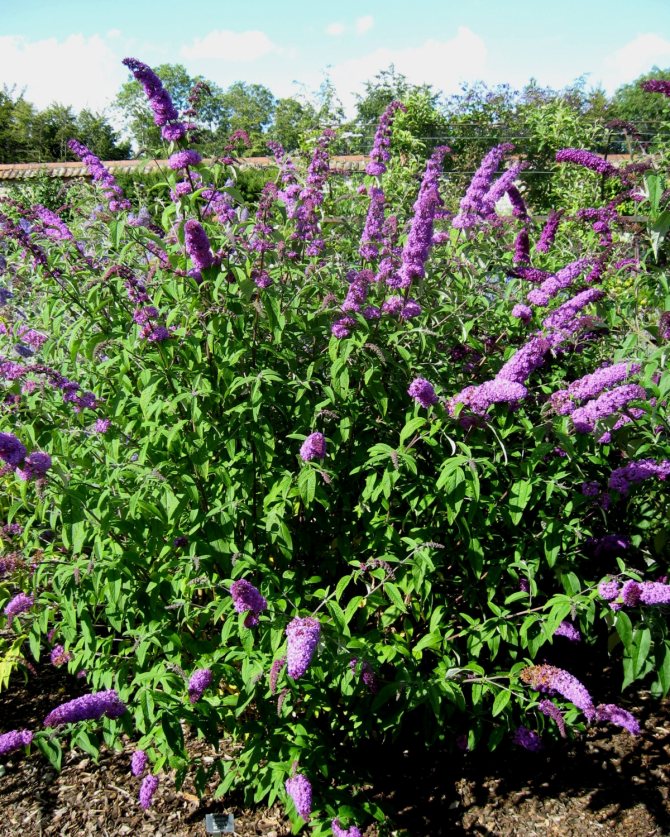

Photo: <>
The best time to transplant buddleya is spring, when the soil is already well warmed up and frosts are not expected. The shrub does not like transplanting, since it has a taproot, which lies quite deep, so it is worth changing the place in extreme cases and is preferable in the spring. If this extreme case has come, then you need to know the features of the autumn transplant.
Shelter creation
After the preparation of perennial crops for wintering is completed, it is time to move on to the shelter. Most varieties of daylilies of domestic selection are considered frost-resistant and do not require additional shelter for the winter.To increase winter hardiness, garden crops are mulched with a layer of peat, tree bark, straw, hay, small spruce twigs and dry sand.
Evergreen and deciduous varieties of daylilies (Evergreen, Semievergreen, Dormant, etc.) do not withstand the harsh Russian winters, therefore they need additional insulation. Flowering perennials are covered with spruce branches, geotextile, lutrasil or spunbond.
Winter protection for bushes consists of two mandatory measures - mulching the roots and erecting a shelter. To prevent the roots from freezing, they must be covered with a 15–20 cm organic layer (foliage, needles or peat). Sphagnum moss is ideal for this purpose.
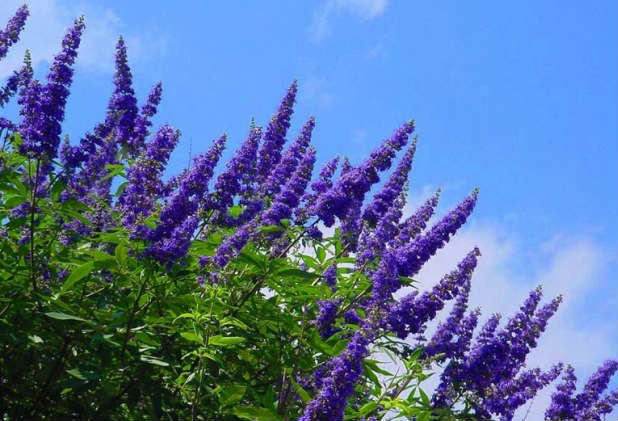

The crown of shrubs needs protection not only from frost, but also from the wind, heavy snow, and the scorching February sun. Only a frame shelter can cope with this task. Such structures can be purchased ready-made or built on their own. Let's take a closer look at how and what is the best way to cover rhododendrons for the winter.
In any garden store, you can buy budget shelters specifically for rhododendrons or azaleas. There is no fundamental difference, since both plants belong to the same species. The shelter is a wire frame, on top of which a garden batting cover is stretched, which is fixed at the bottom. In use, it is convenient, quickly installed and dismantled, however, many gardeners note the low strength of such structures.
It is safer to make a shelter on your own in the form of a hut or "house" 1–1.4 m high. This design will not allow snow to linger, ensure normal air exchange and prevent damage to branches.
For the construction of the frame, you can use any available materials available on the farm:
- plastic or metal arcs;
- thin boards, wooden beams;
- pieces of metal reinforcement;
- for shelter: garden batting, burlap, corrugated cardboard, plywood;
- small plants can be covered with a cardboard box.
You can not use polyethylene or spunbond for shelter - condensation accumulates under these materials, which leads to debate and rotting of plants.
Landmark for varieties
Varietal characteristics are an important criterion on which the care of rhododendrons and shelter in the fall depends. All shrubs are different: some are sensitive to cold, others to sun and moisture, so each species has its own rules:
- deciduous varieties with flexible shoots up to 1.5 m high for the winter are bent to the ground and sprinkled with a thick layer of foliage, needles or peat;
- low deciduous rhododendrons are tied at the top, and if the bush is very sprawling, it is additionally pulled together with a rope so that the buds do not come into contact with the covering material;
- evergreen species up to 1 m high are covered with a burlap cover, undersized bushes can be covered with spruce branches;
- dwarf Japanese varieties 0.3–0.5 m high are watered abundantly and covered with a cover, sometimes such plants are transplanted into pots and kept in a cool place until spring;
- multi-flowered varieties are not afraid of frost, therefore they are closed only from the sun using a frame covered with non-woven material.
Major mistakes
What mistakes in the shelter process can interfere with a successful wintering:
- too thin arcs of the frame - they can bend under the weight of the snow;
- the close location of the branches to the frame - in contact with the frozen shelter, the buds quickly freeze;
- cover not fixed at the bottom;
- lack of mulch - leads to freezing of the roots;
- insufficient watering in front of the shelter;
- premature shelter;
- use of film.
Dismantle the frame in the spring, when not only the air, but also the soil warms up. If the winter is late and the ground has not thawed, you can water the bush with warm water - this procedure will warm the soil and make the plant wake up.








